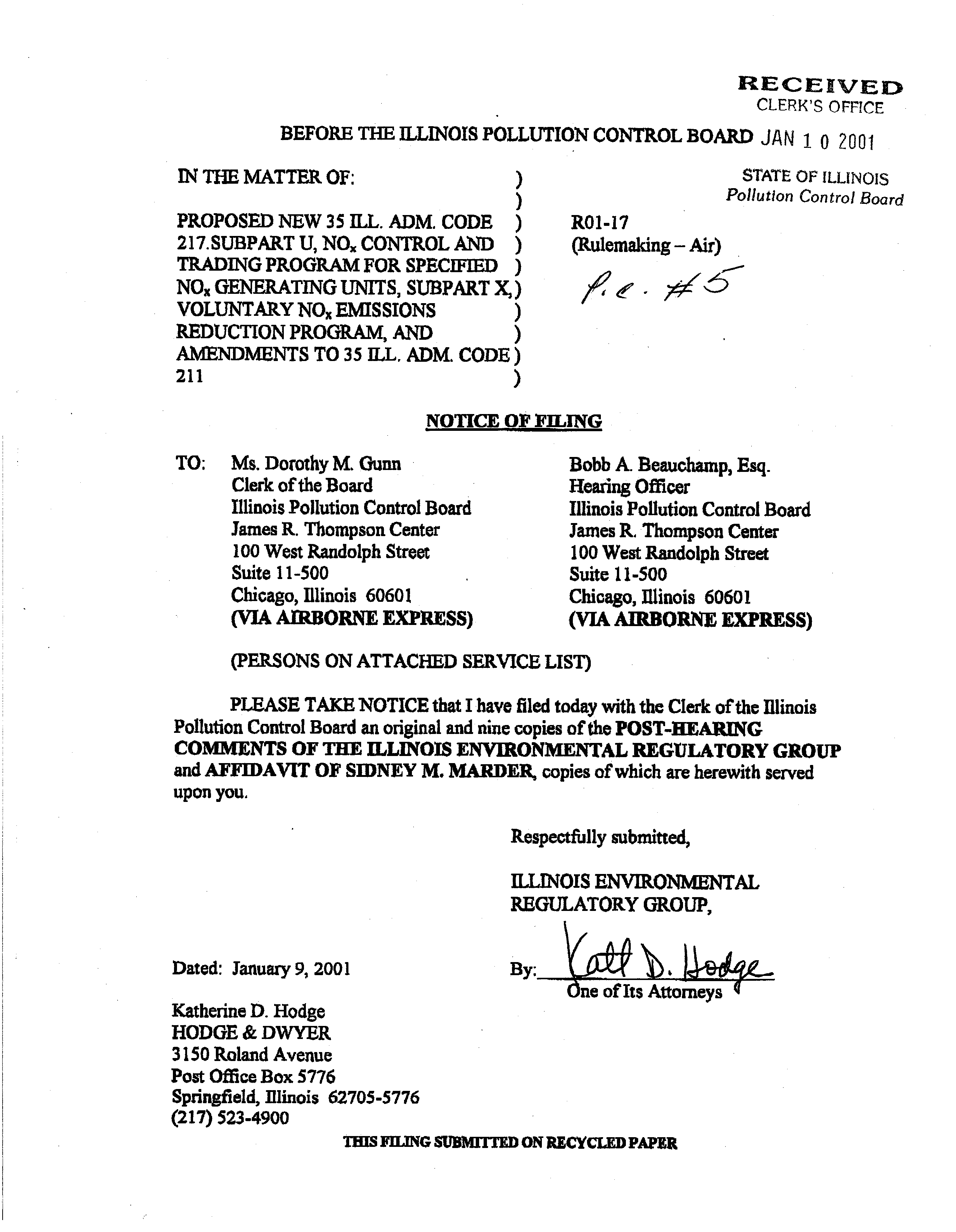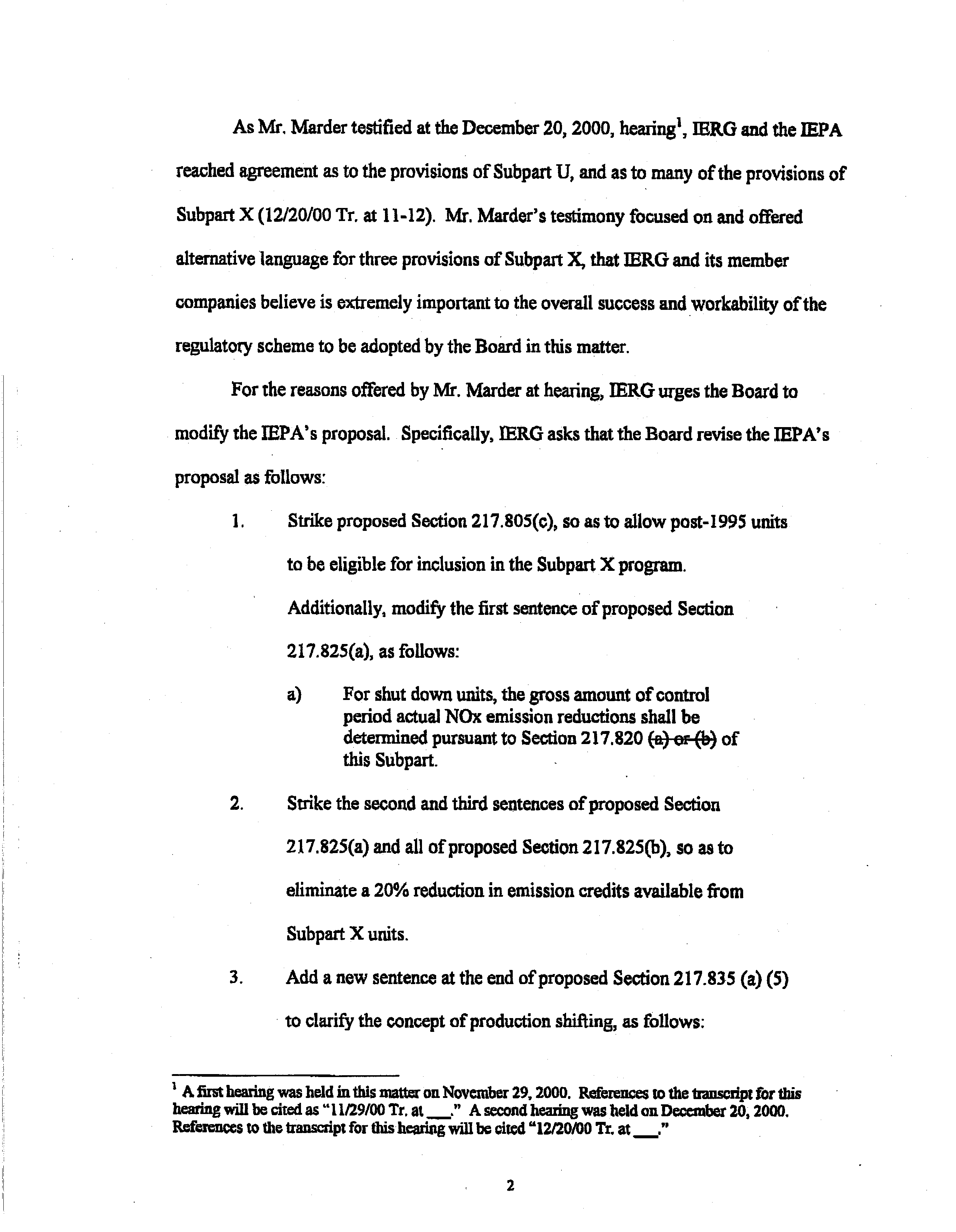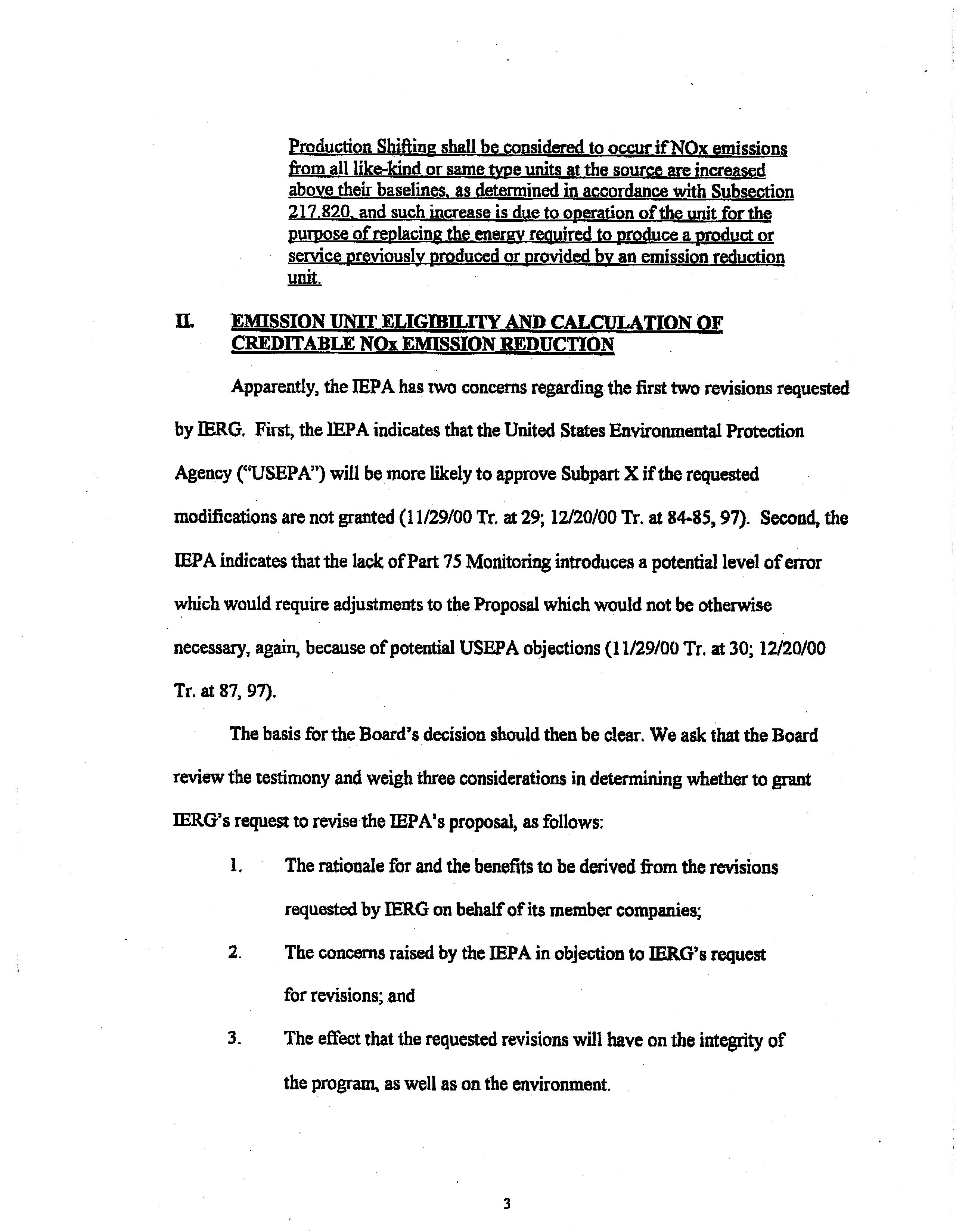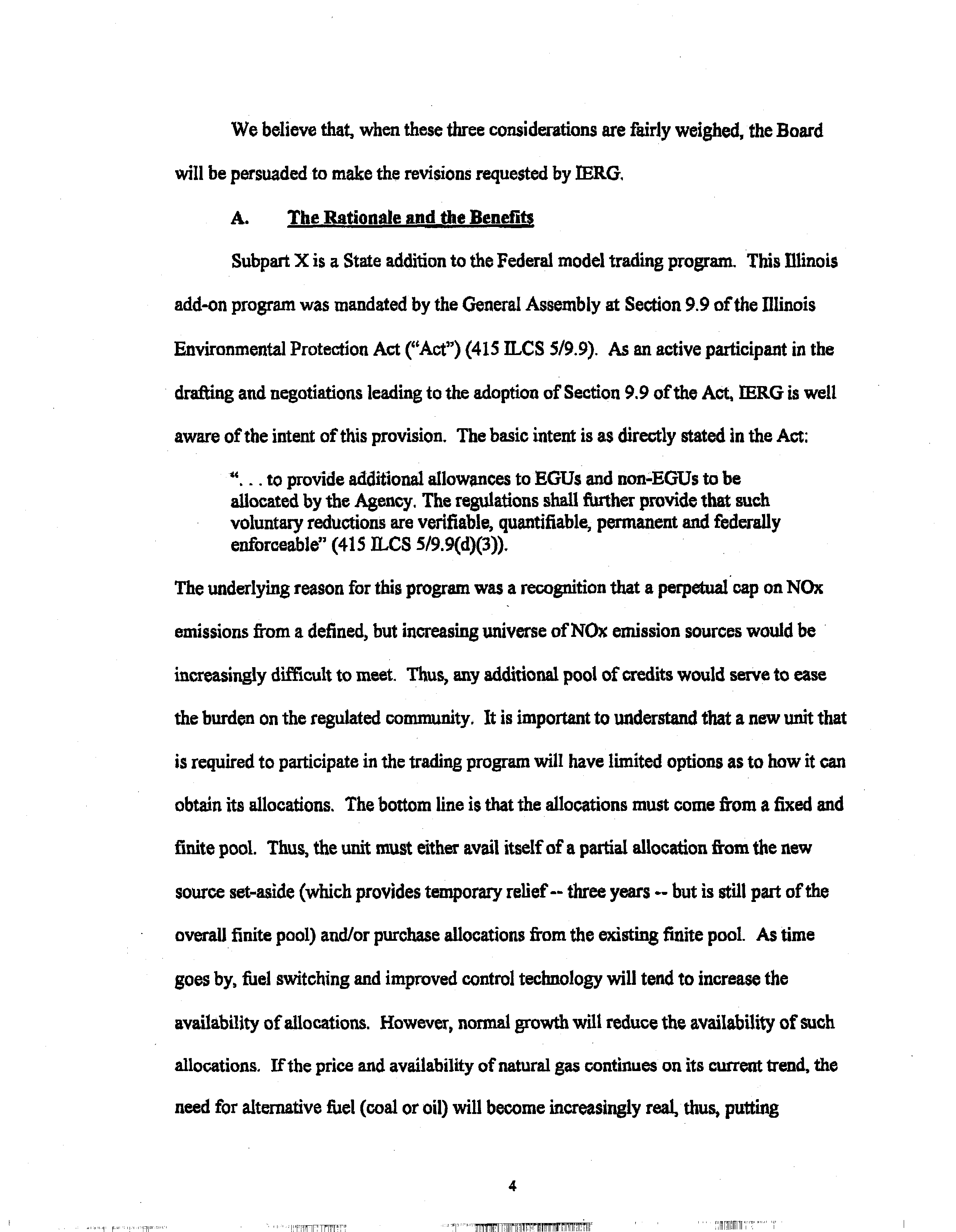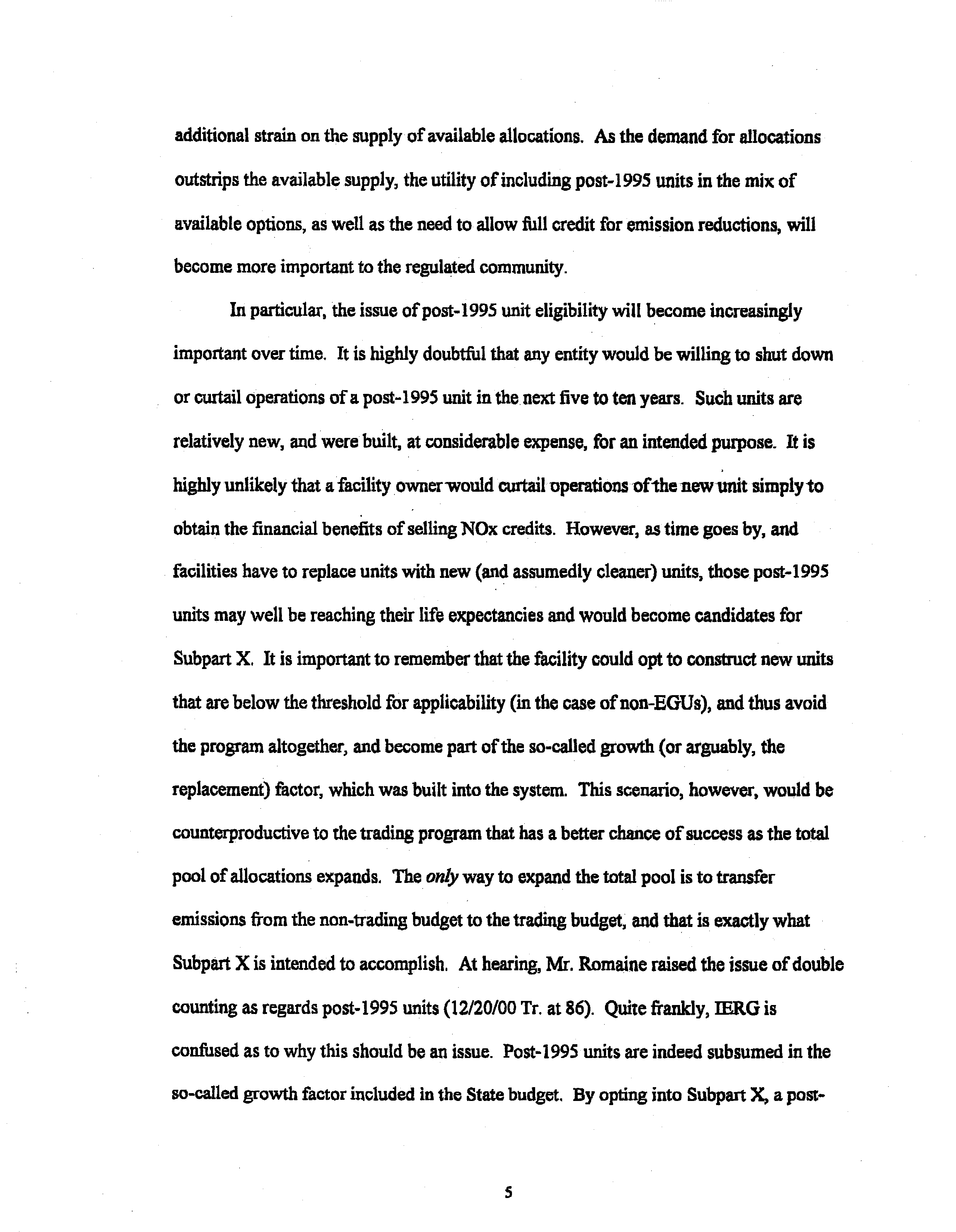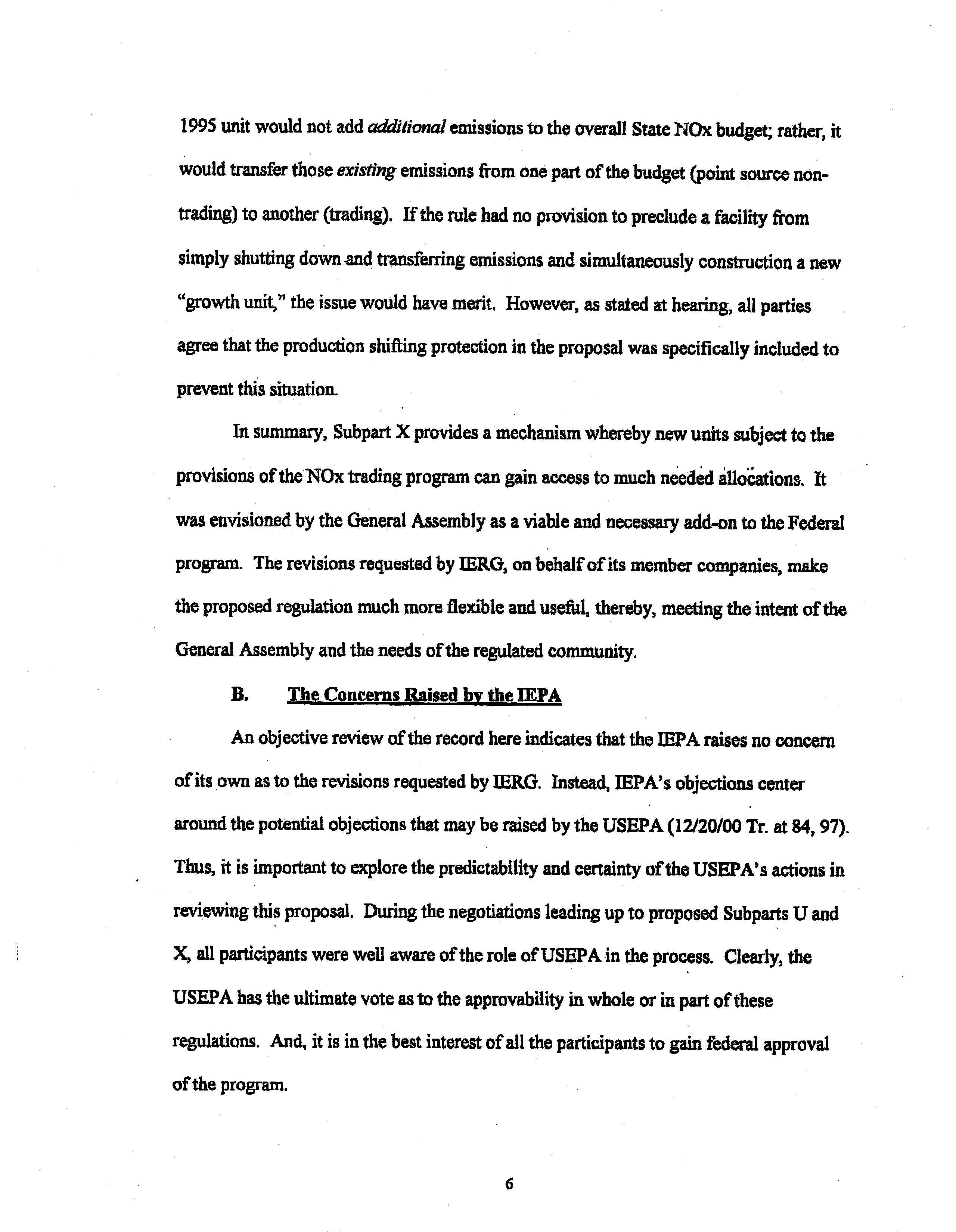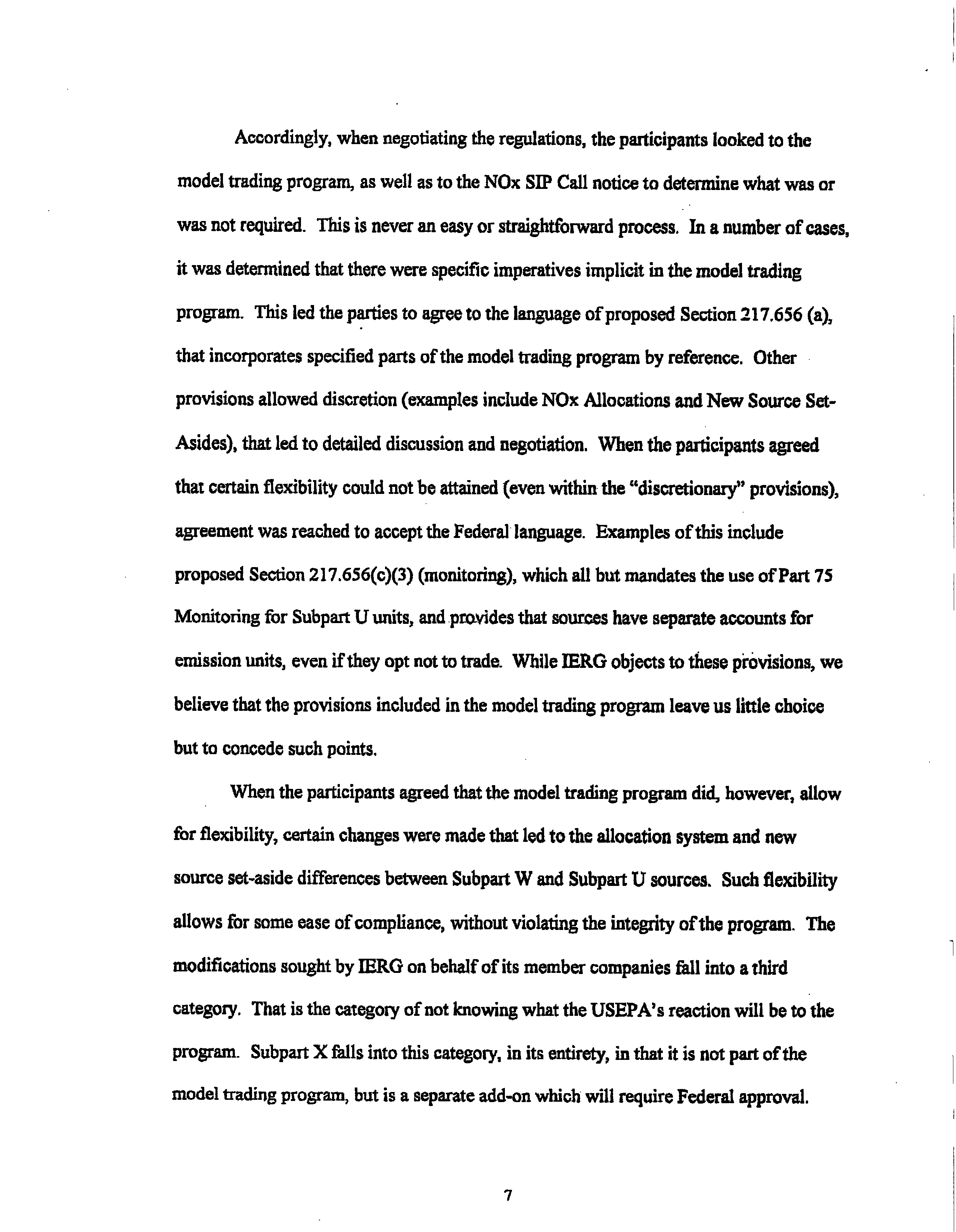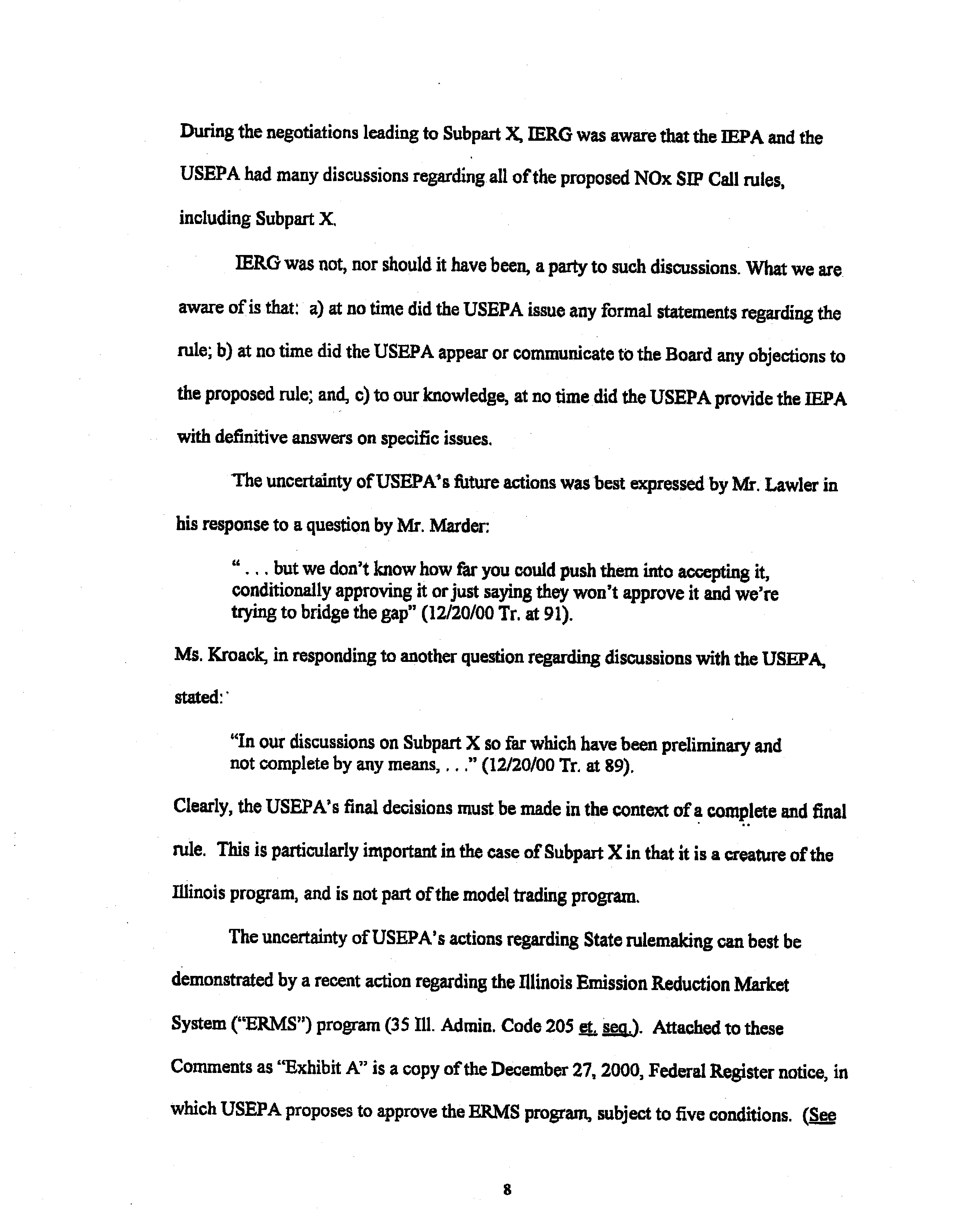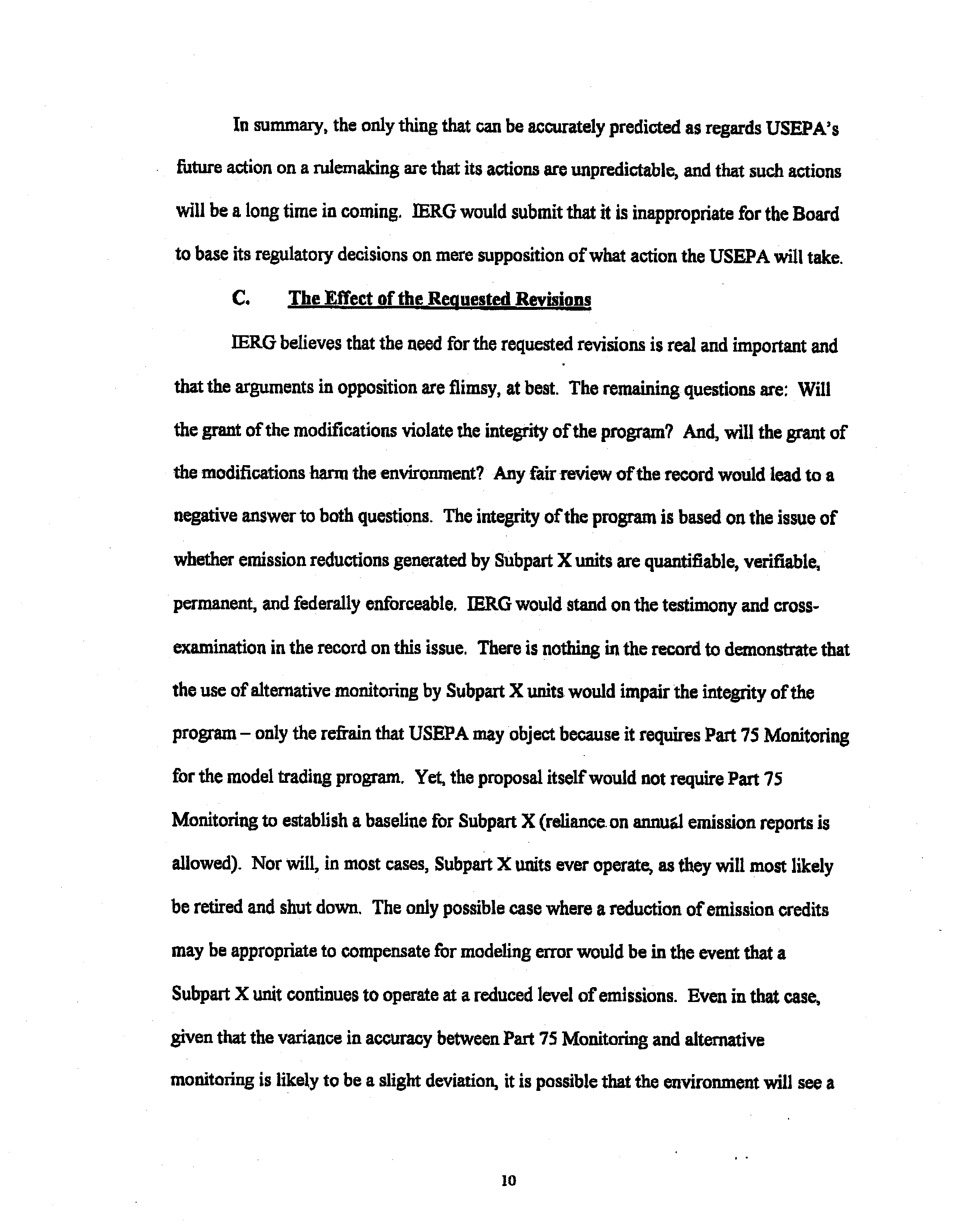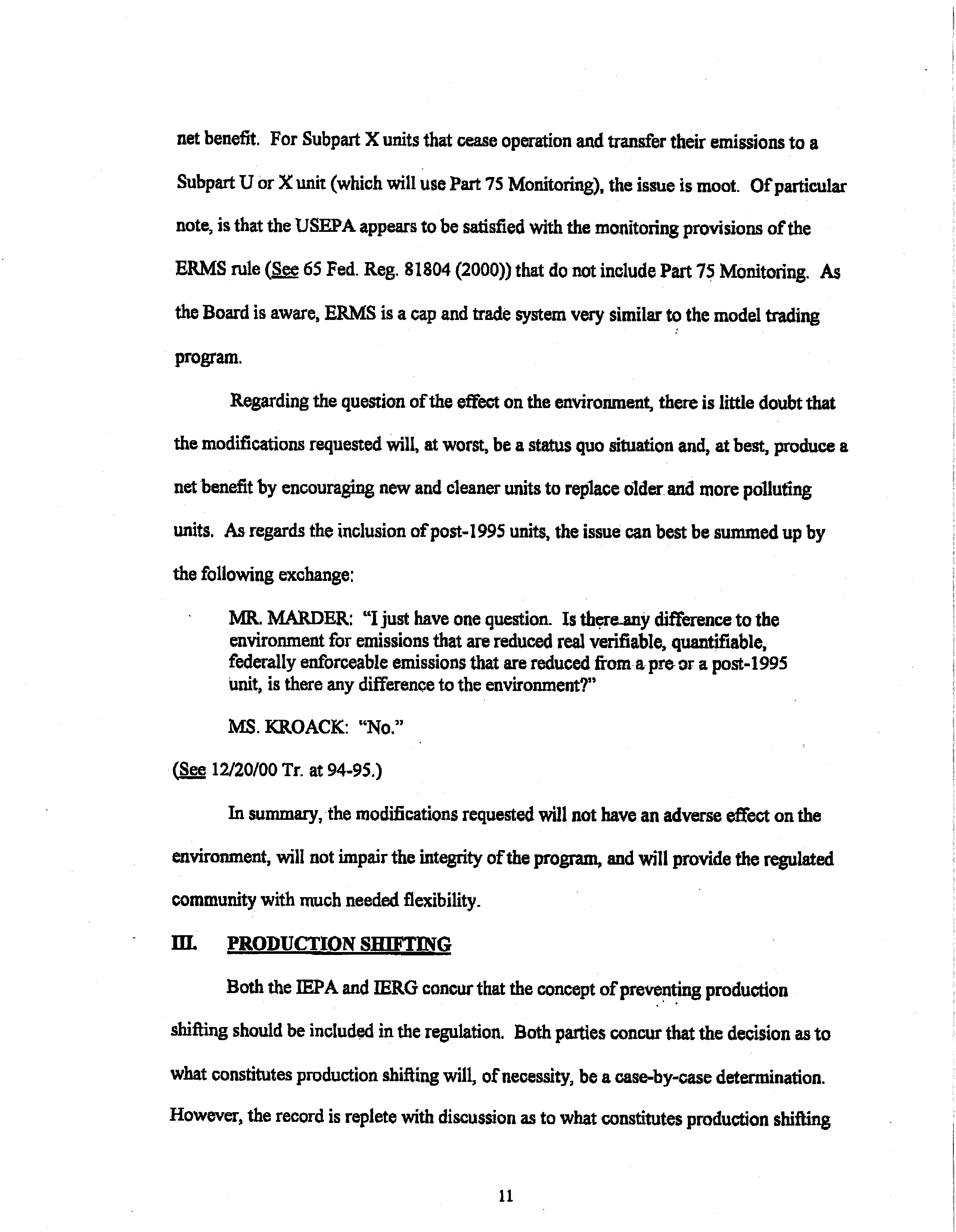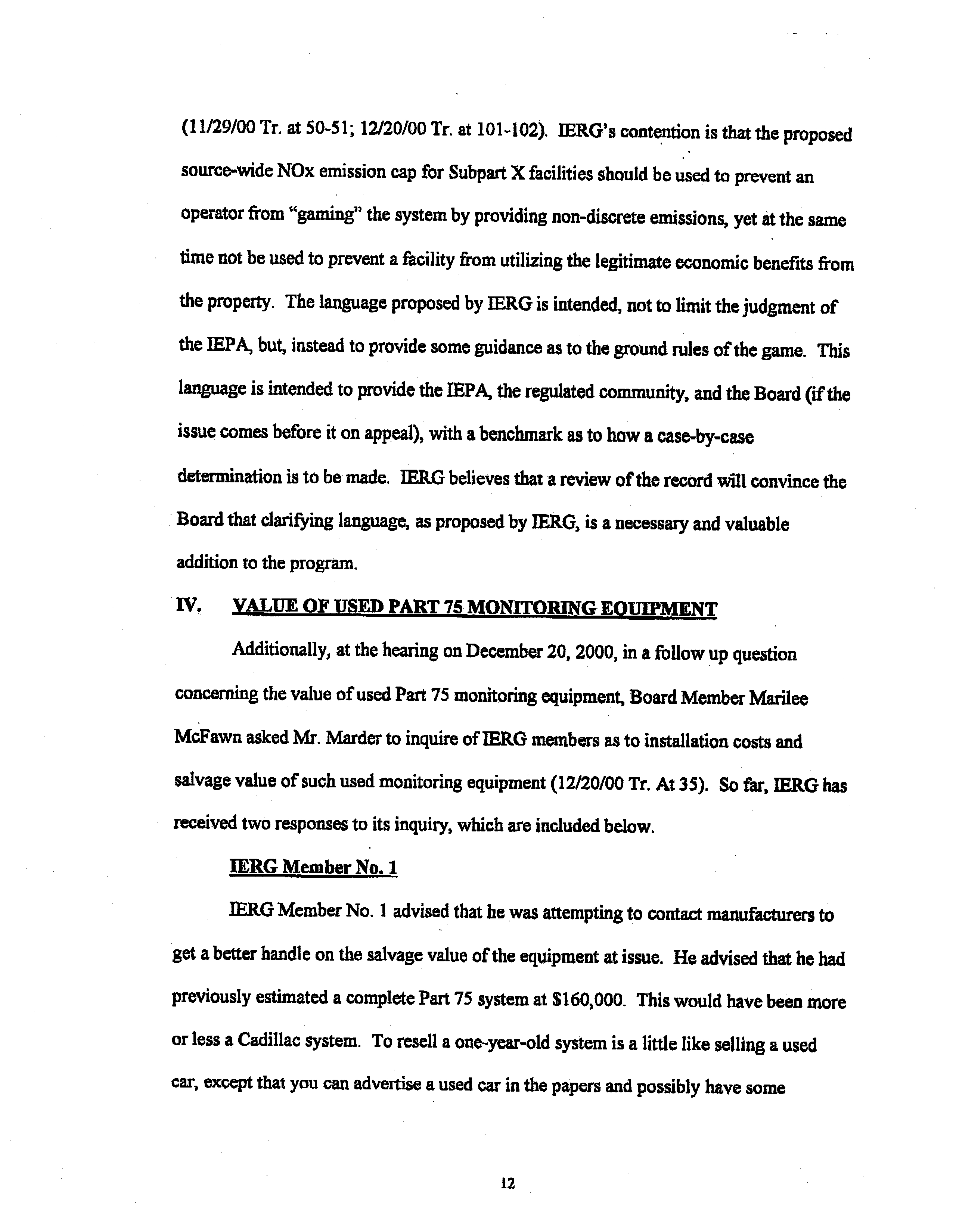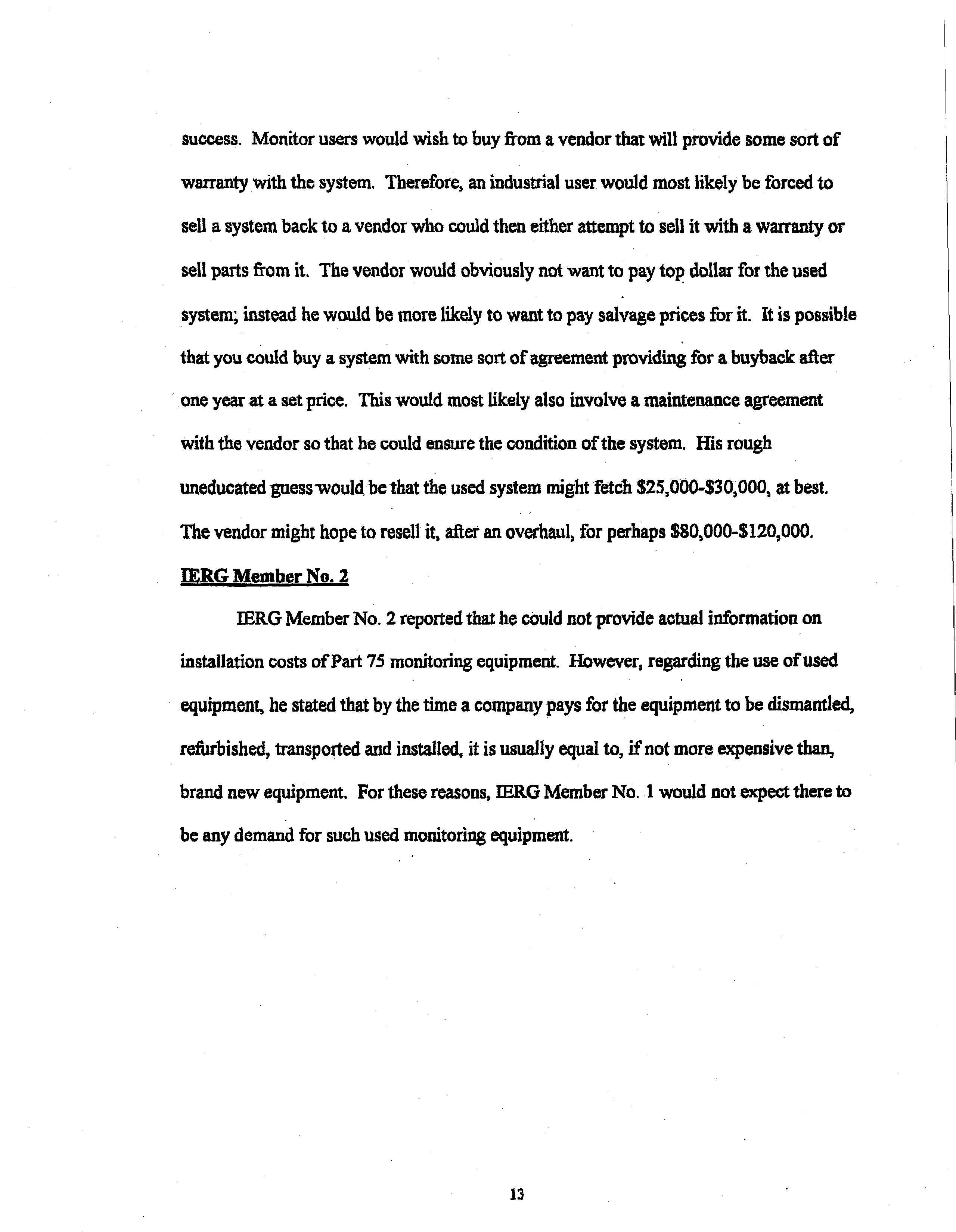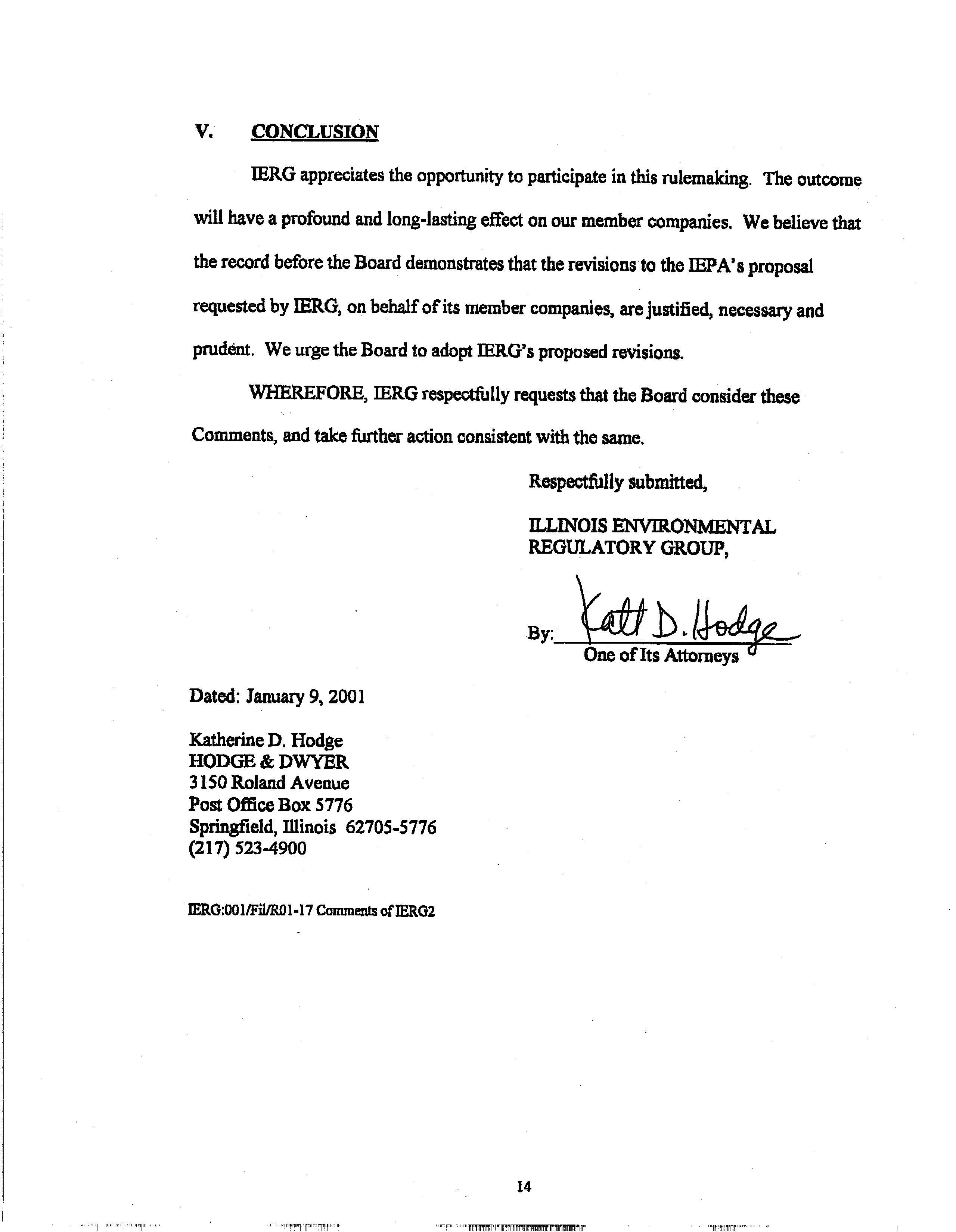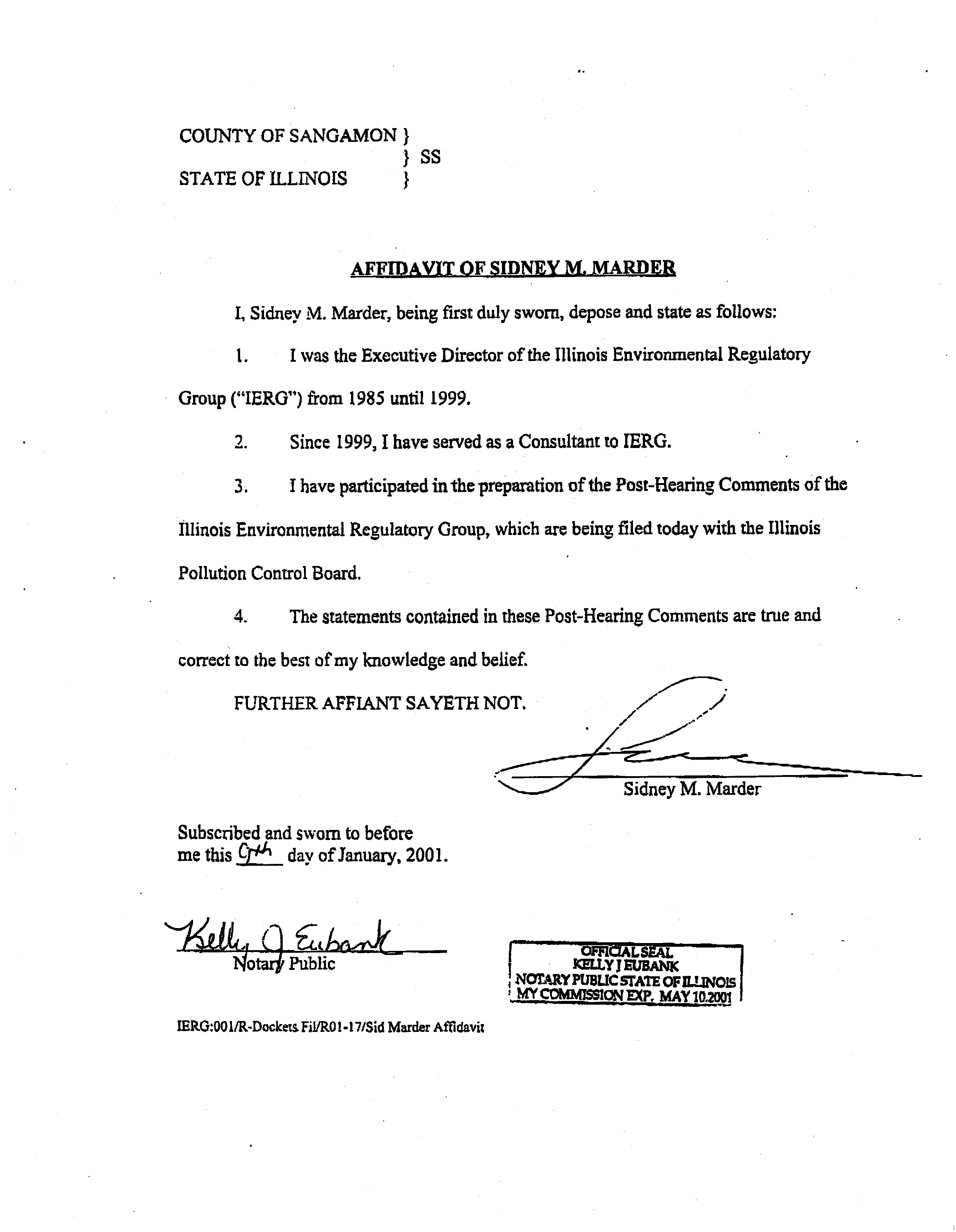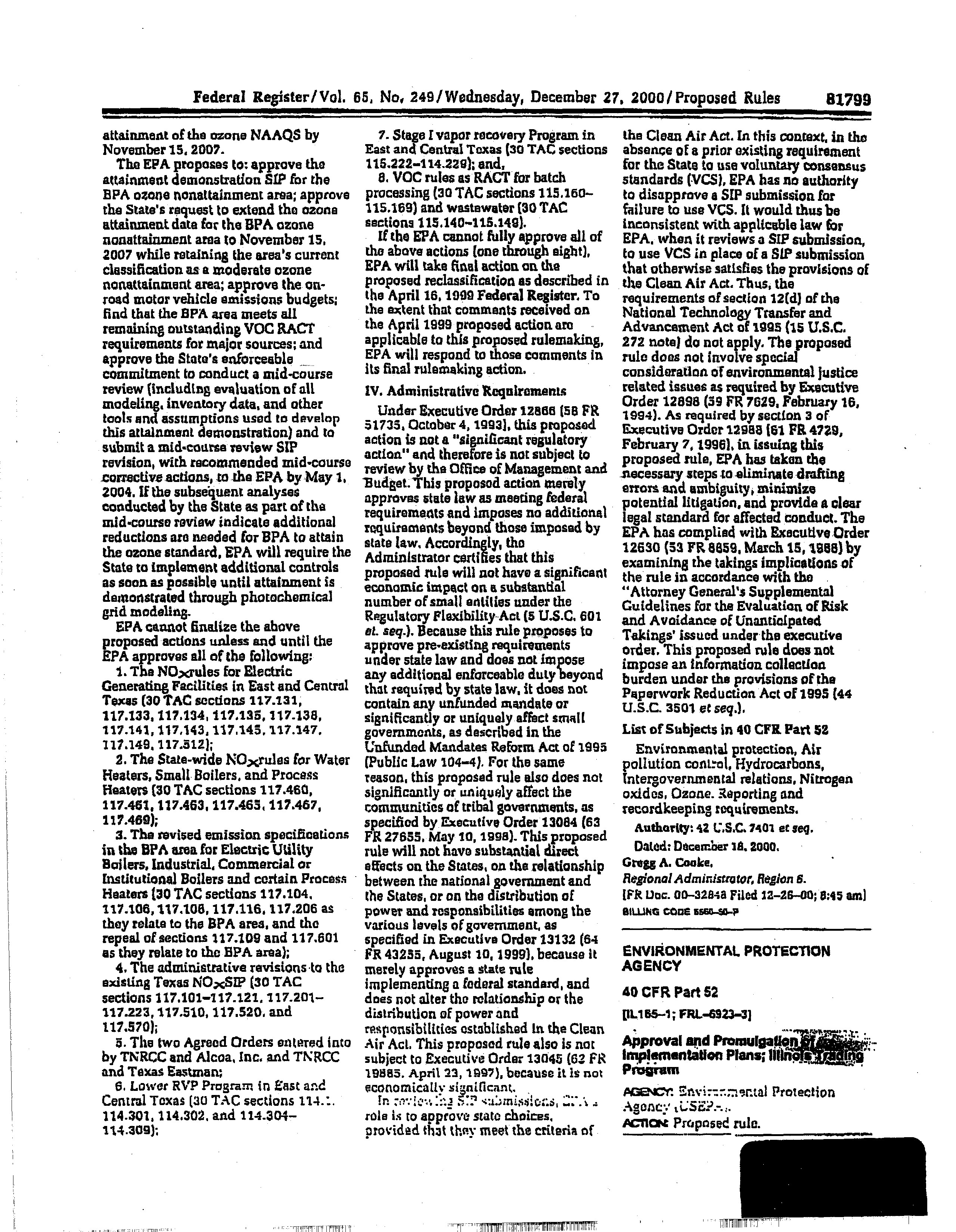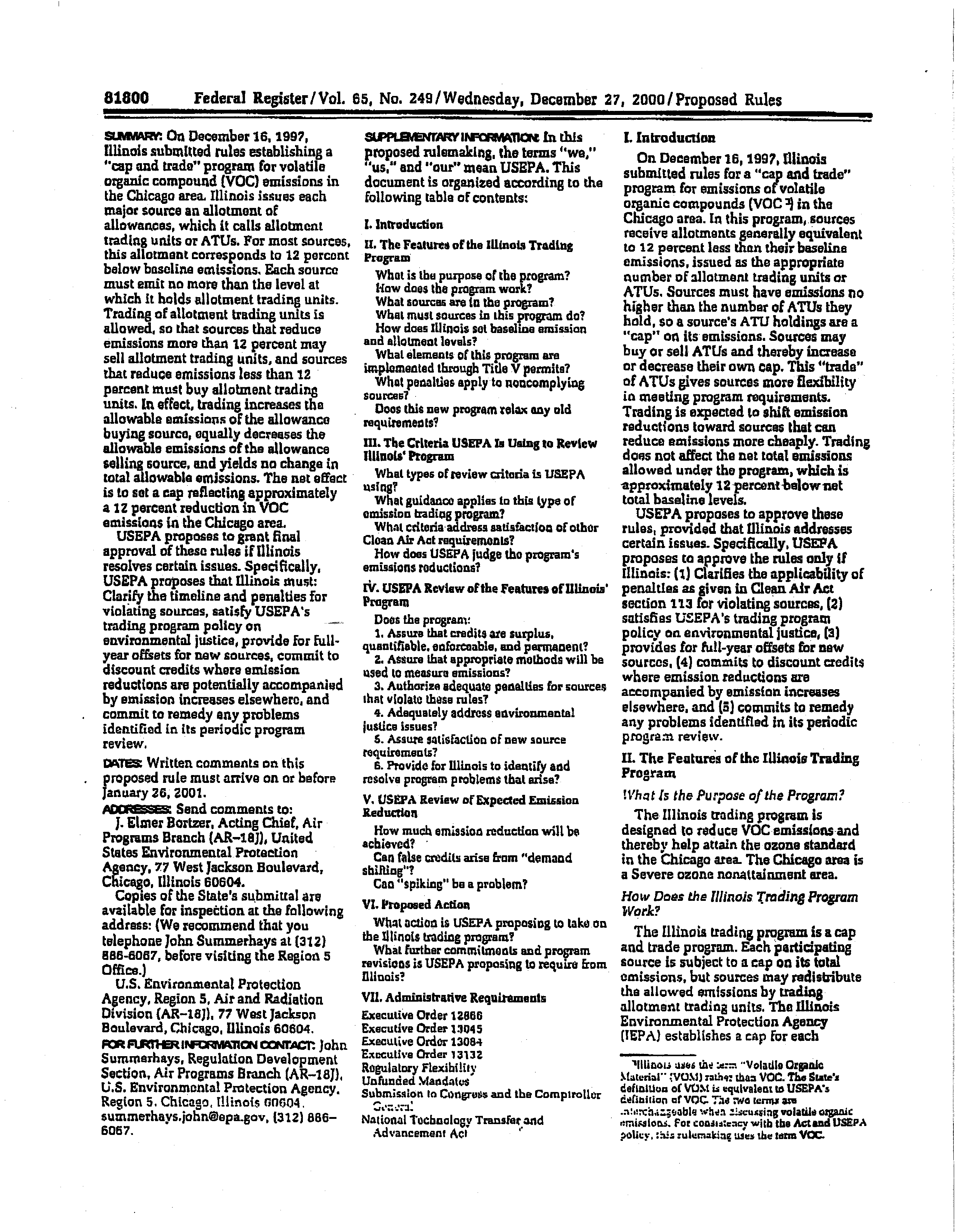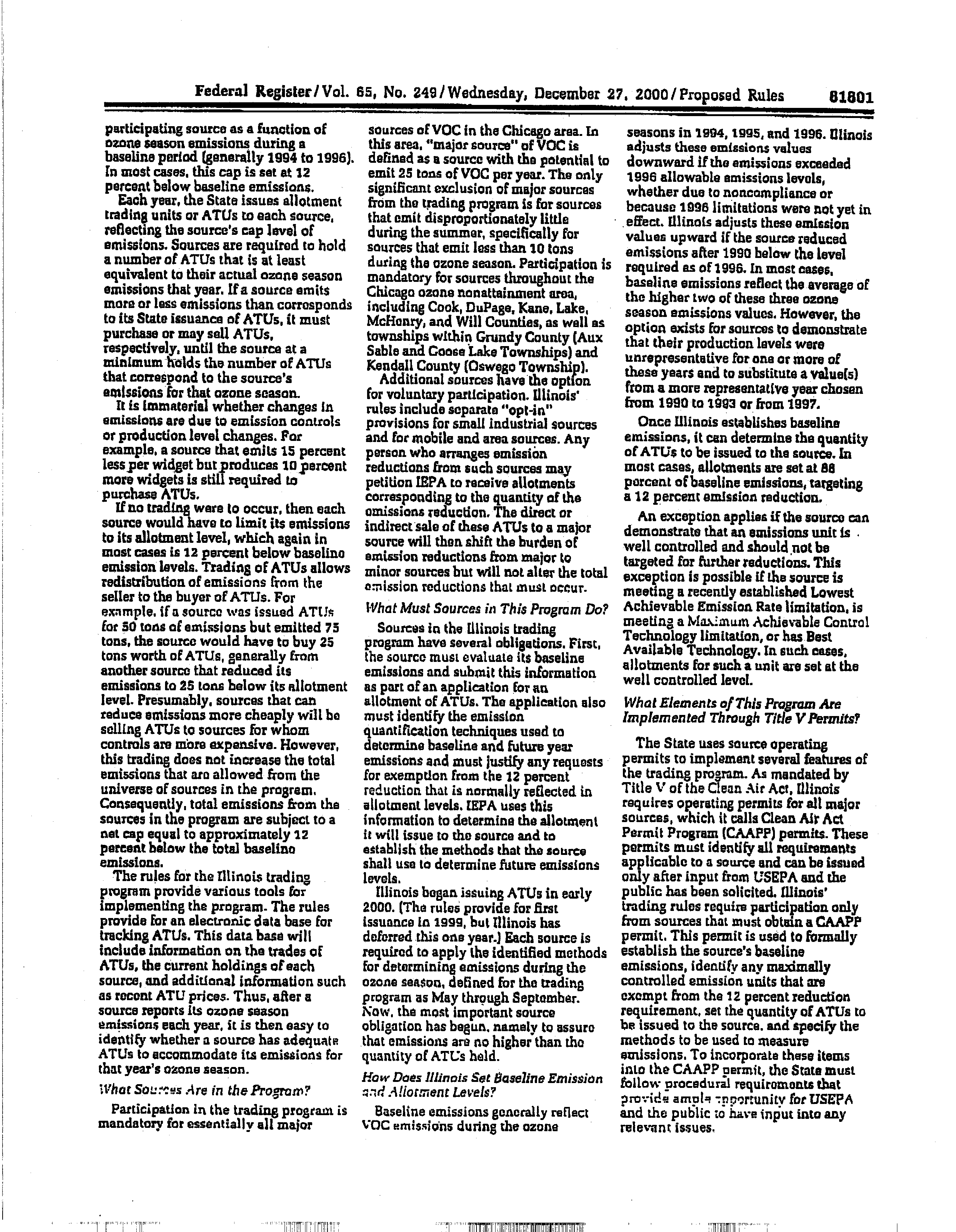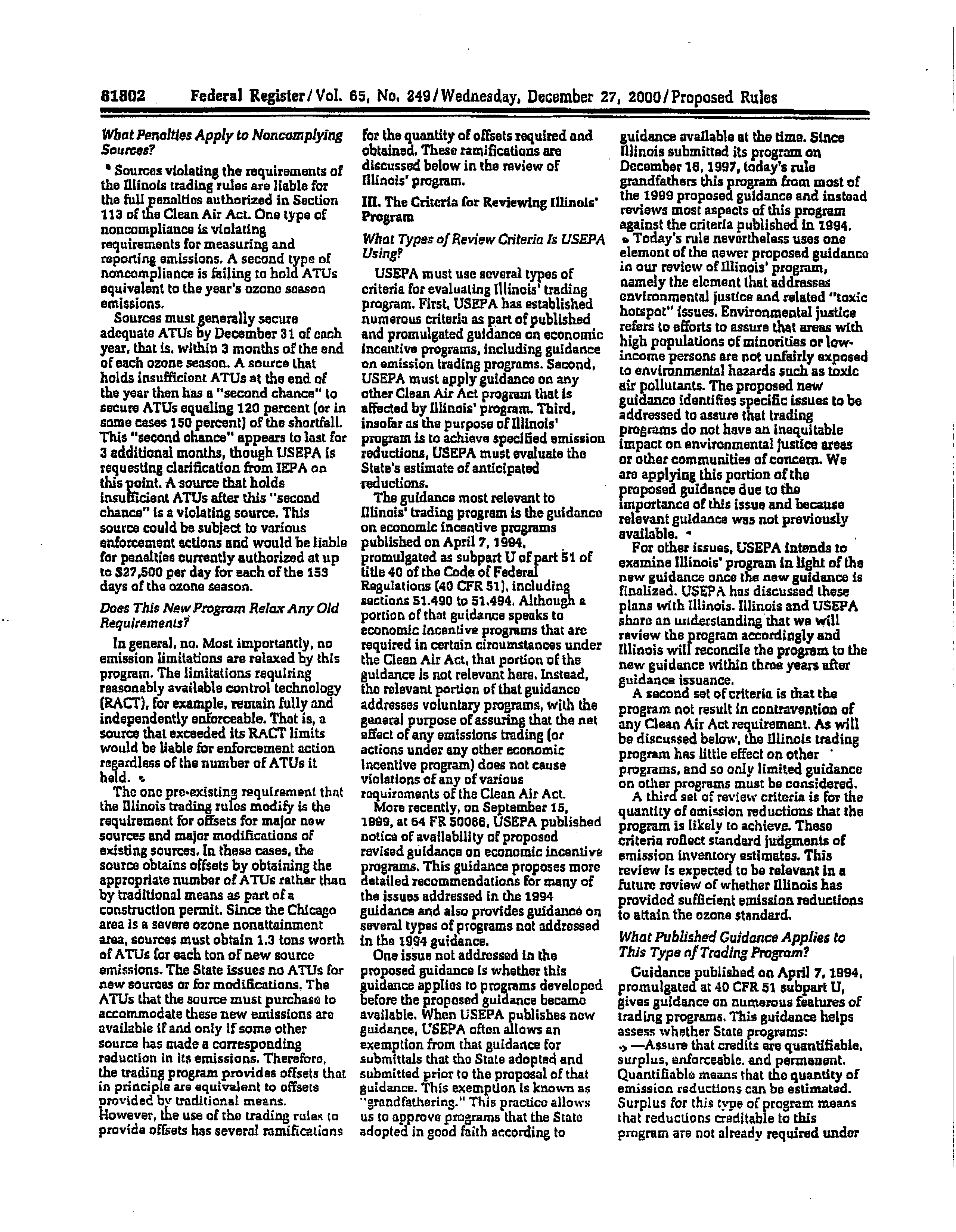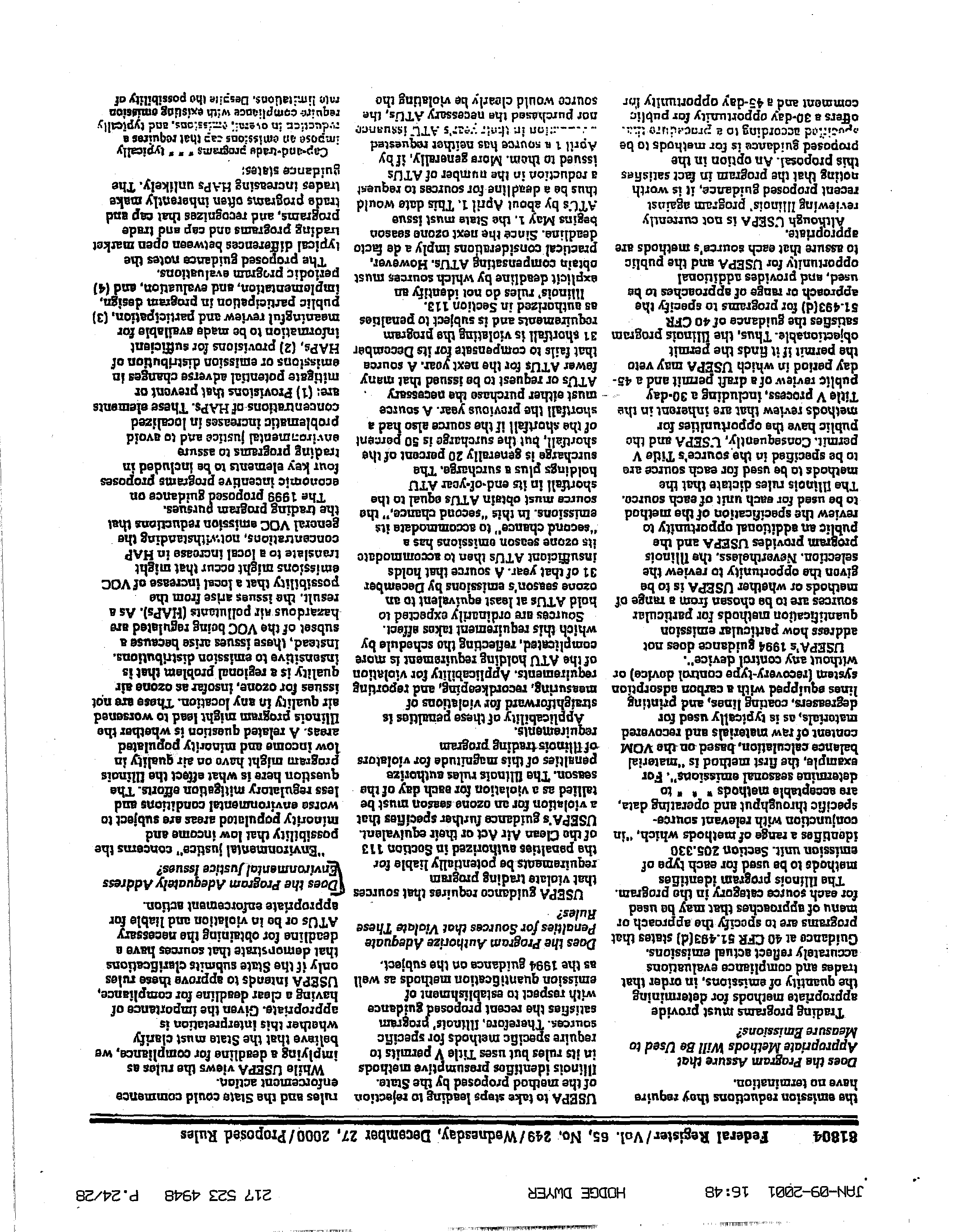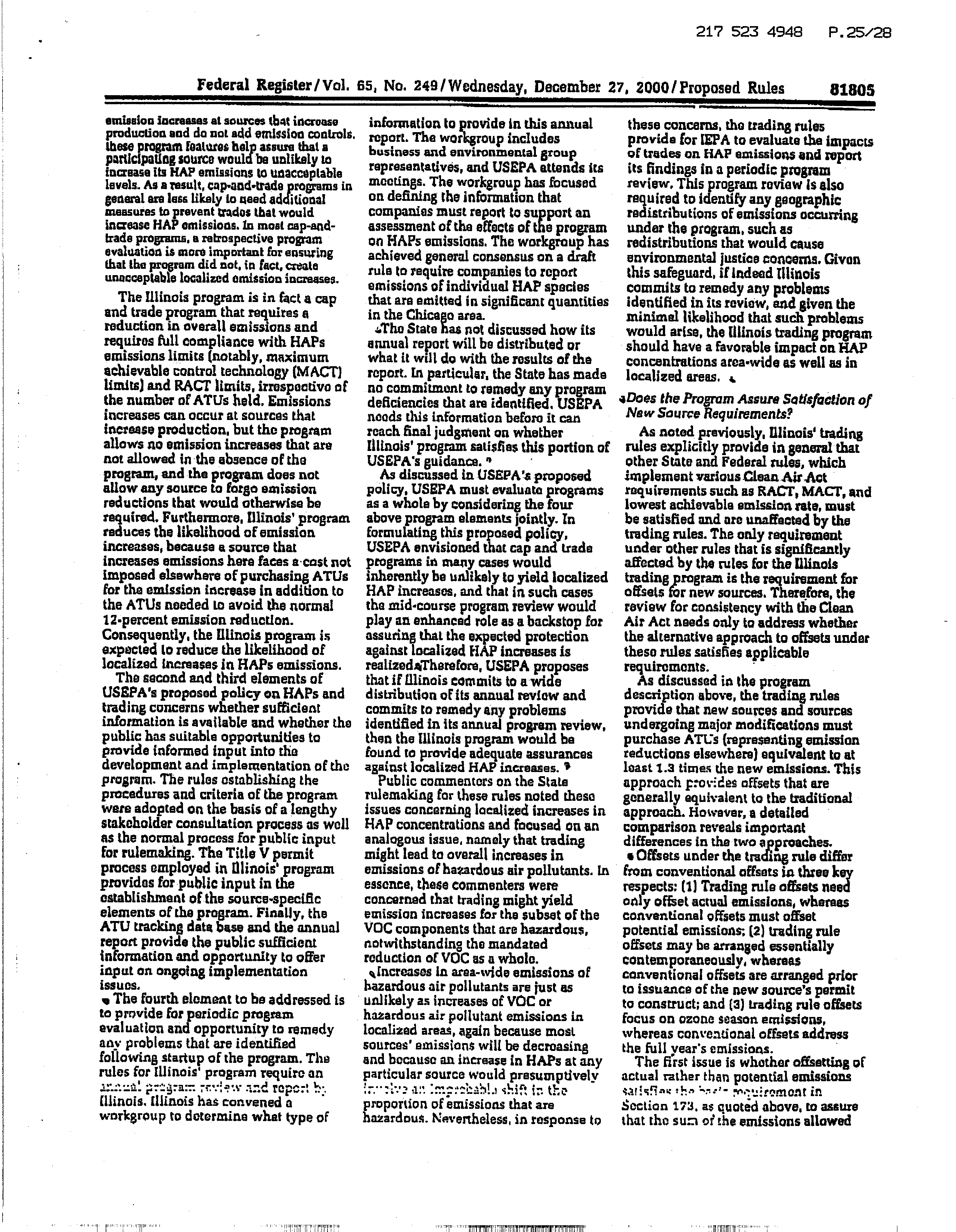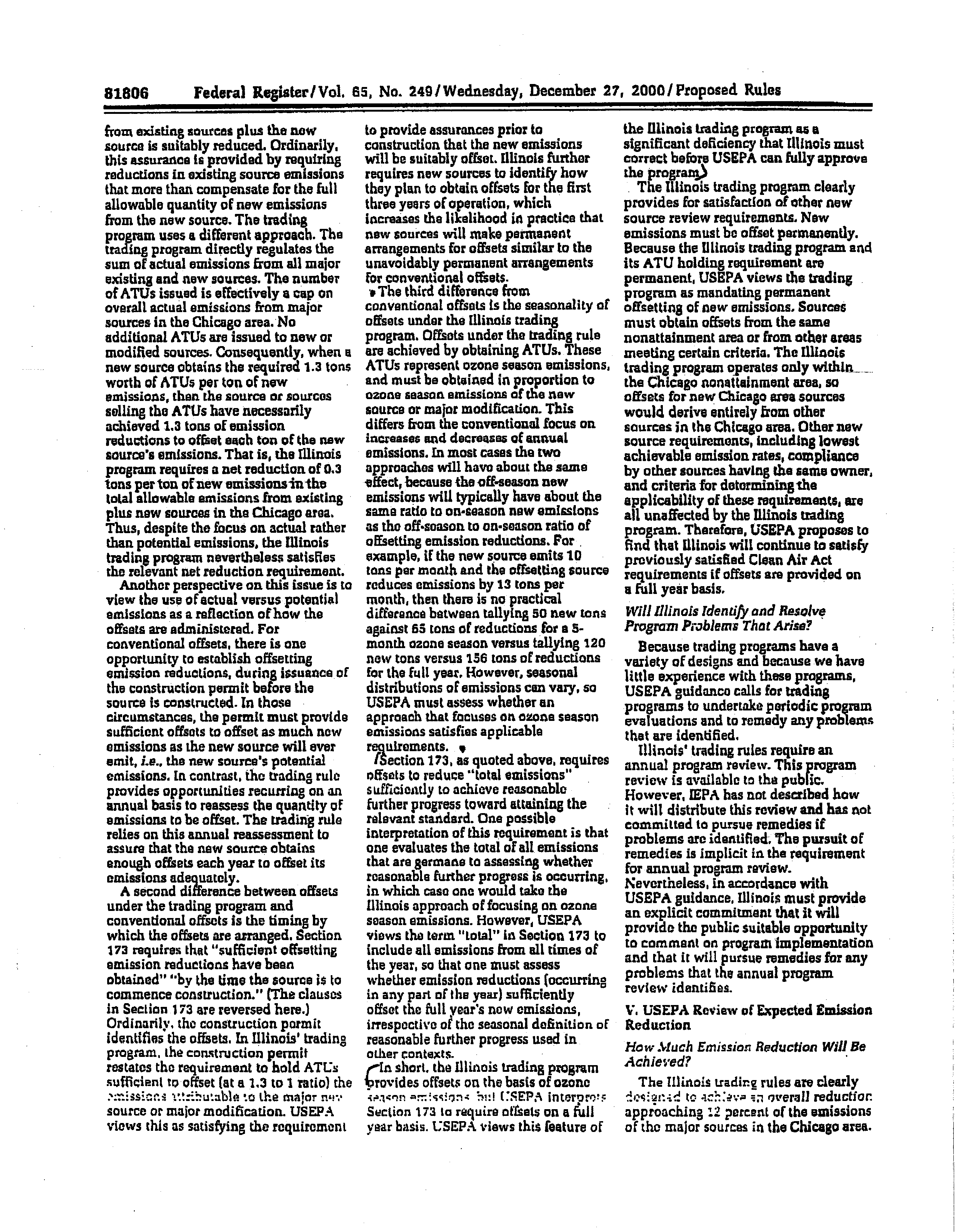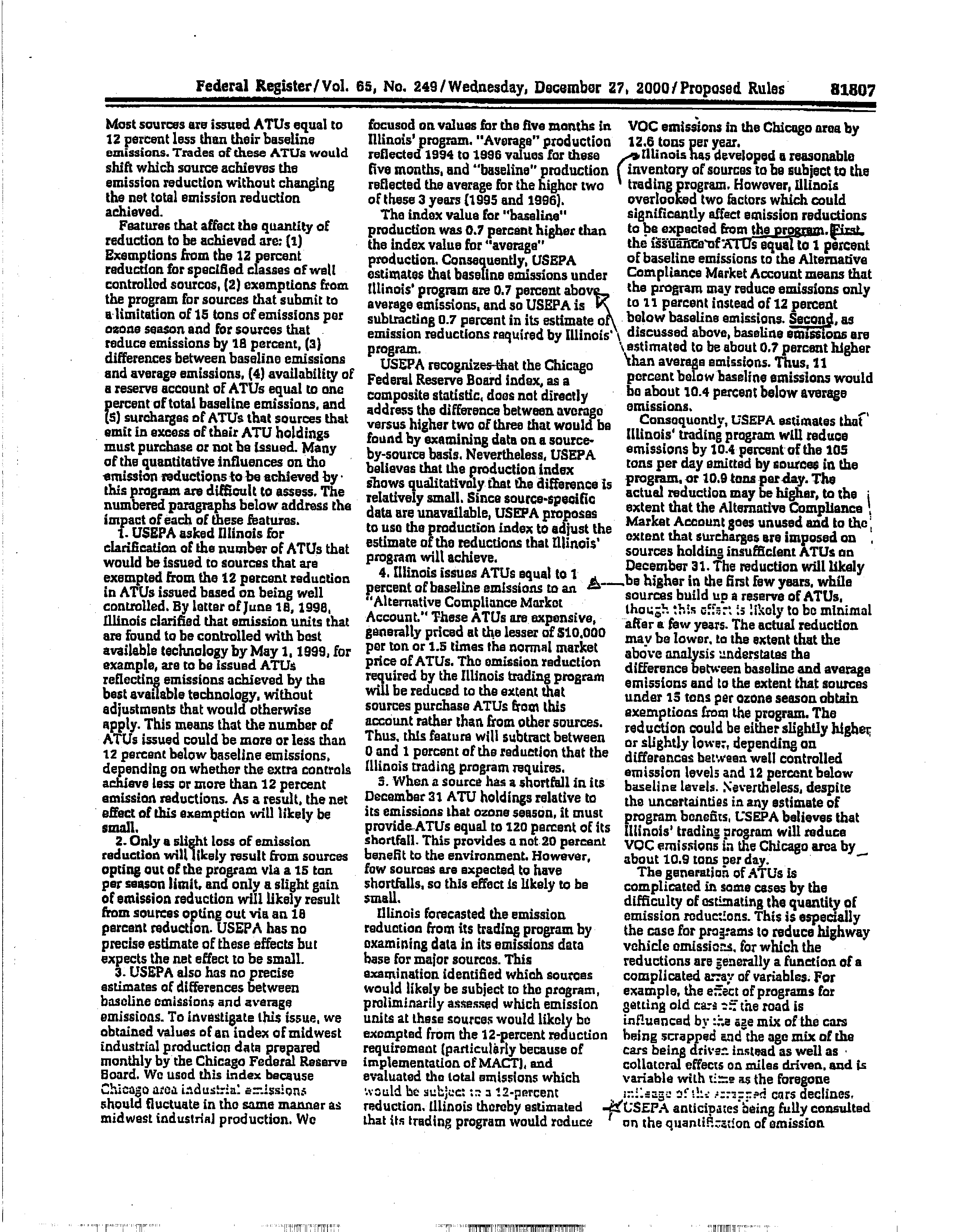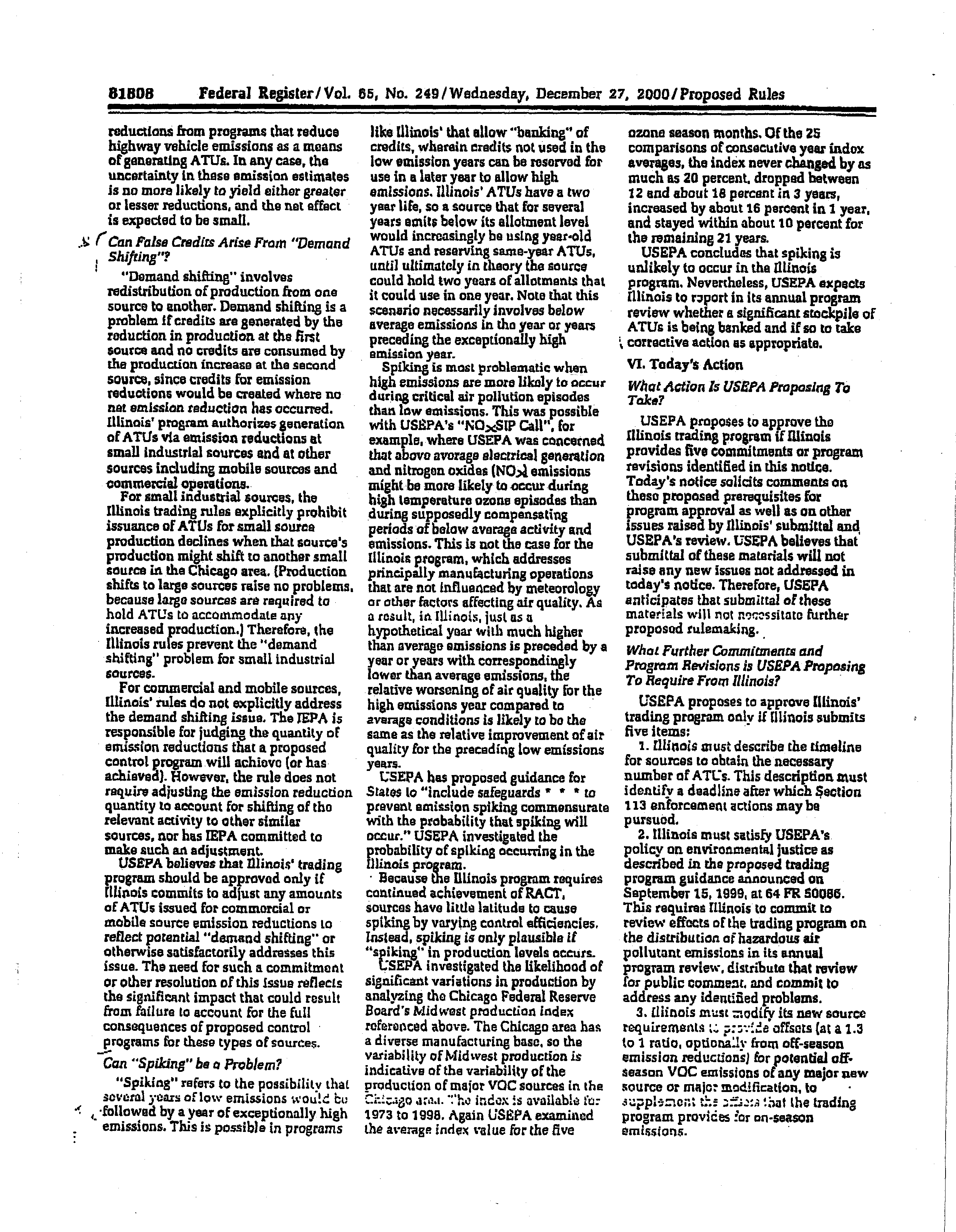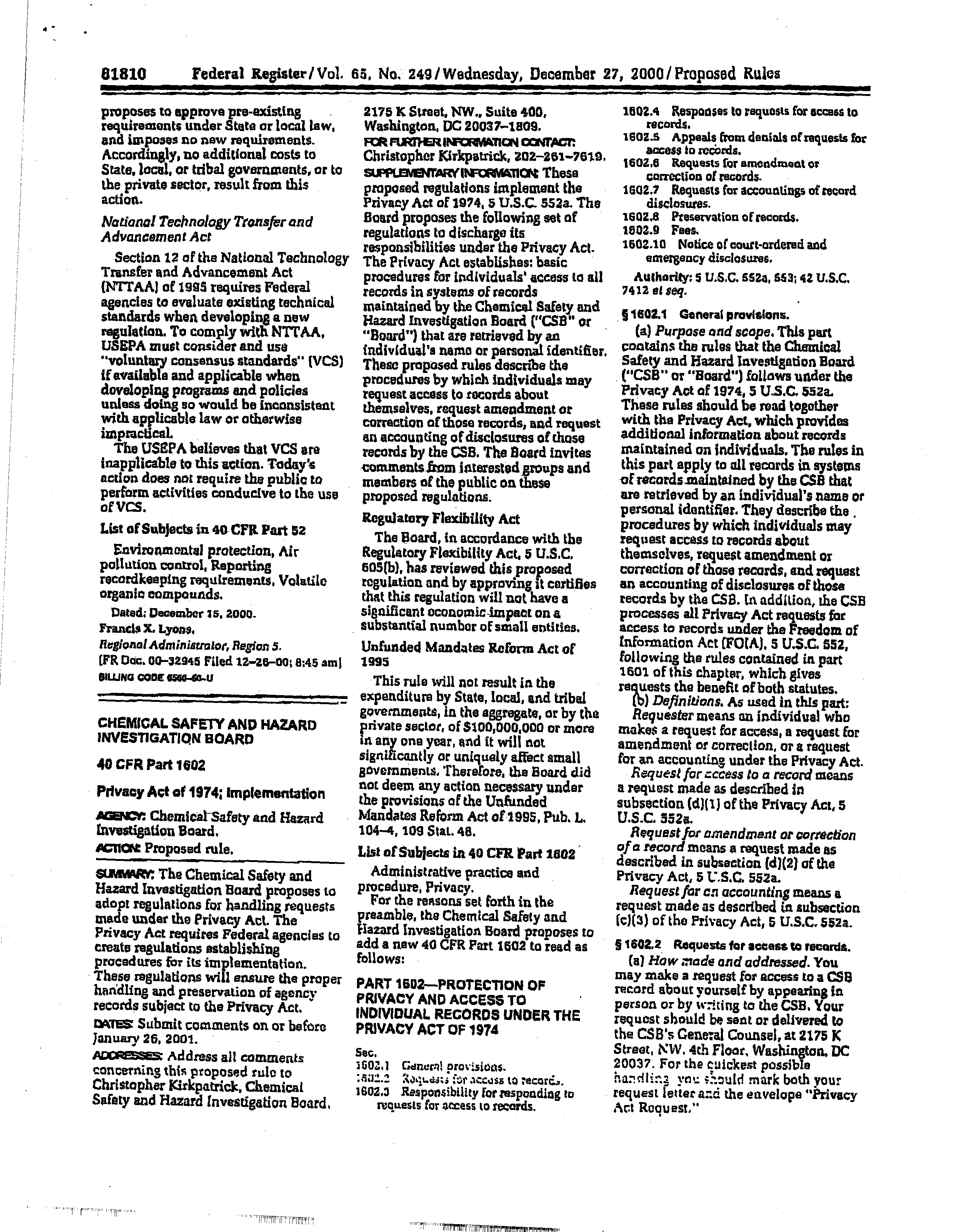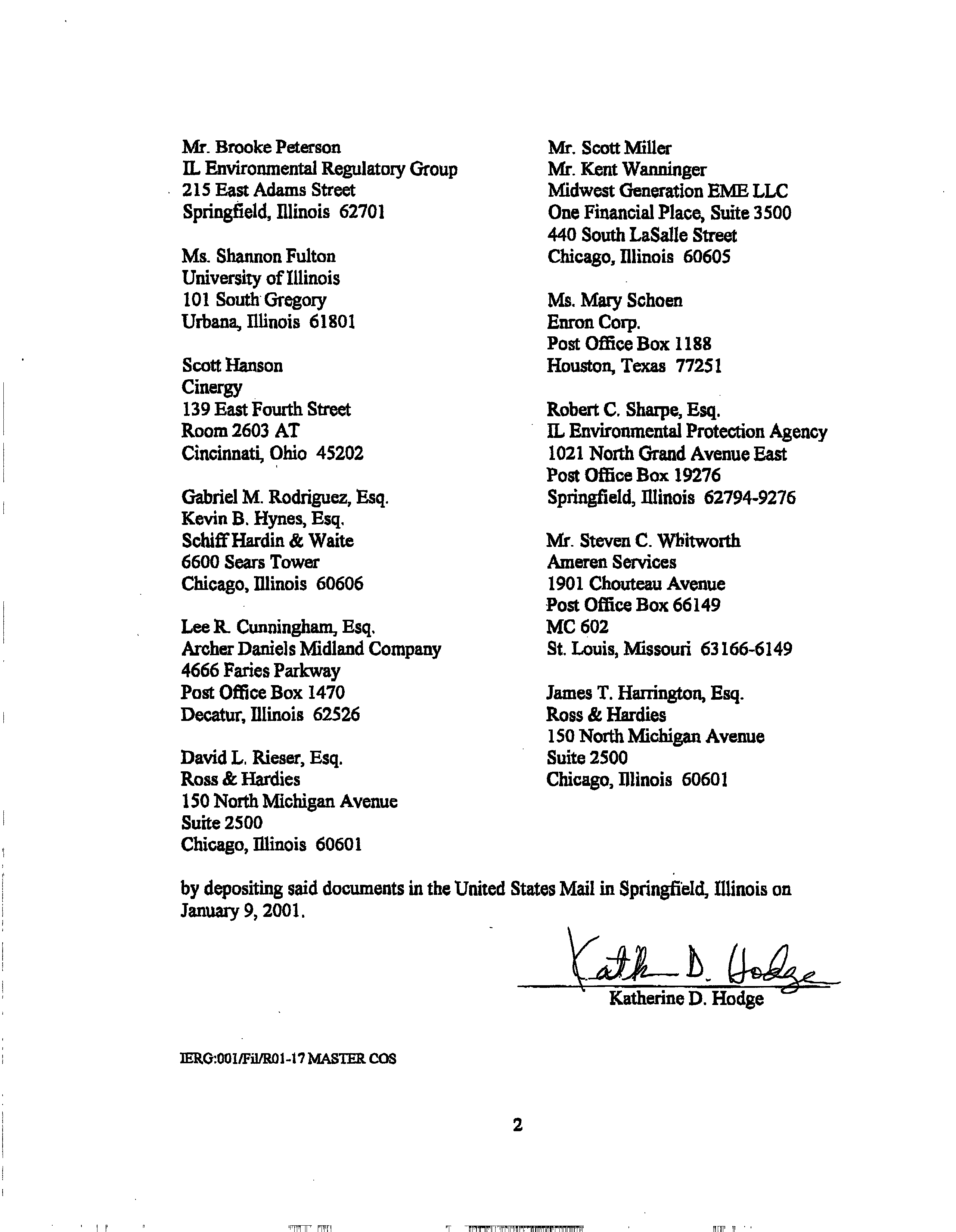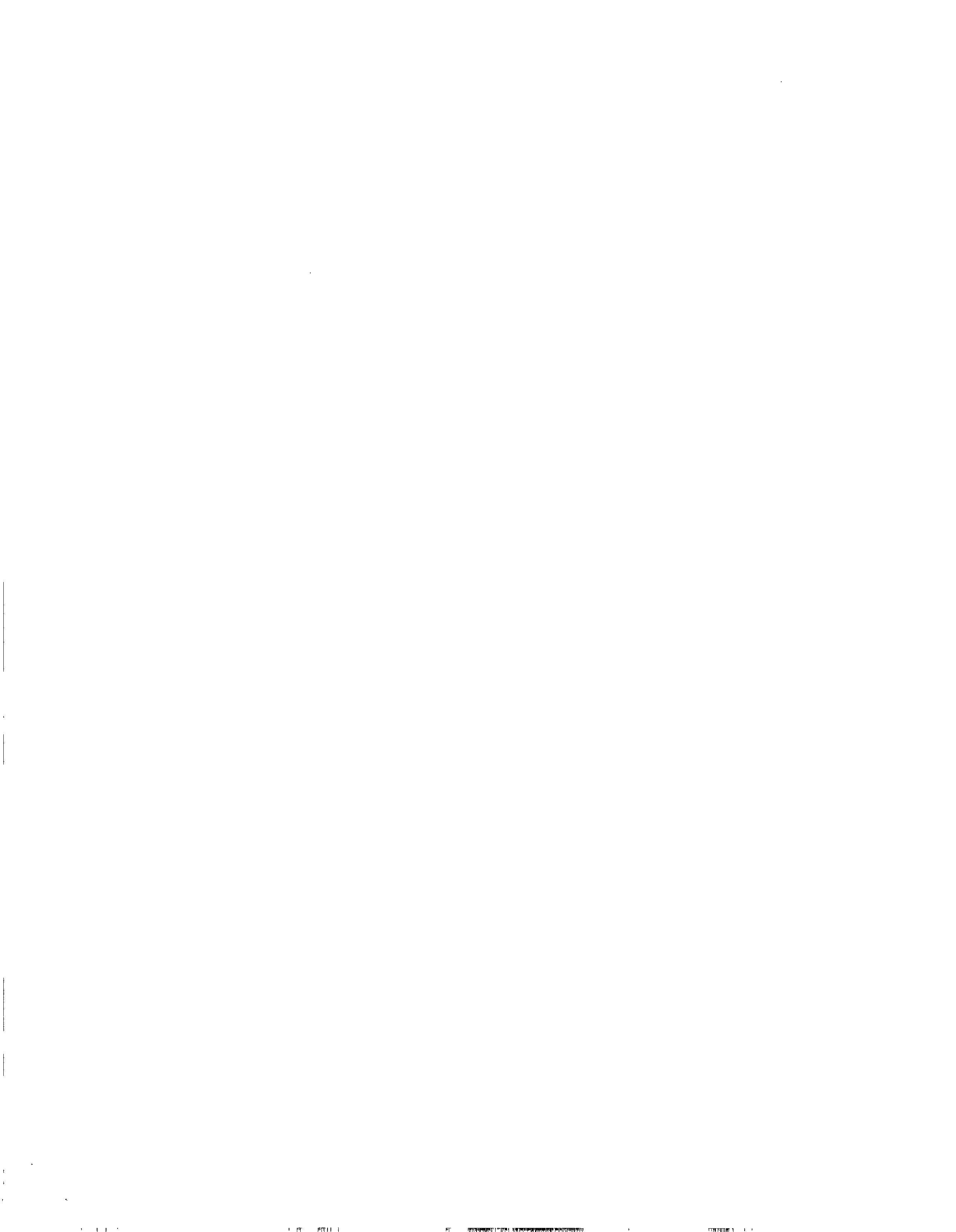RECEIVED
CLERK~S
OFF!CE
BEFORE THE ILLiNOIS POLLUTION CONTROL BOARD
JAN
1
0
2001
iN TUE MATTER OF:
)
)
PROPOSED NEW 35 ILL. ADM.
CODE
)
217.SUBPART U, NO~ CONTROL AND
)
TRADING PROGRAM FOR SPECIFIED
)
NO~ GENERATING UNITS, SUBPART X~)
VOLUNTARYNO~ EMISSIONS
)
REDUCTION PROGRAM, AND
)
AMENDMENTS TO
35 ILL. ADM. CODE)
211
)
STATE OF ILLINOIS
Pollution
Control Board
RO 1-17
(Rulemaking
—
Air)
t~.
~6=
NOTICE OF
FiLING
TO:
Ms. Dorothy M. Gunn
Clerk ofthe Board
IllinoisPollution Control Board
James R. Thompson Center
100 West Randolph Street
Suite 11-500
Chicago, Illinois
60601
(VIA
AIRBORNE
EXPRESS)
Bobb A. Beauchamp, Esq.
fleming Officer
Illinois Follution Control floard
James R. Thompson Center
100 WestRandolph
Sweet
Suite
11-500
Chicago, illinois
60601
(VIA AIRBORNE
EXPRESS)
(PERSONS ONATTACHED
SERVICE LIST)
PLEASE TAKENOTICE that I have filed today with the Clerk ofthe illinois
Pollution Control Board an original and nine copies ofthe POST-REARING
COMMENTS OF THE ILLINOIS ENVIRONMENTAL REGULATORY GROUP
and AFFIDAVIT OF SIDNEY M. MARDER~ copies ofwhich are herewith served
upon you.
Respectfi.illy submitted,
Dated:
January 9,
2001
Katherine 1). Hodge
HODGE & DWYER
3150 Roland Avenue
Post Office Box 5776
Springfield, Illinois
62705-5776
(217) 523-4900
ILLiNOIS ENVIRONMENTAL
REGULATORY GROUP,
P~
By:
ne
omeys
THIS FILING SUDMITUED ON RECYCLEDPAPER
RECEIVED
CLERK’S OFFIfF
BEFORE THE ILLINOIS POLLUTION CONTROL BOARDJAN
102001
IN THE MATTER OF:
STATE OF
ILLINOIS
)
Pollution
Control Board
)
PROPOSED NEW 35 ILL. ADM. CODE
)
RO1-17
217.SUBPART U, NOx CONTROL AND
)
(Rulemaking
-
Air)
TRADING PROGRAM FOR SPECIFIED
)
NOx GENERATING UNITS, SUBPART X~)
VOLUNTARYNOx EMISSIONS
)
REDUCTION PROGRAM, AND
)
AMENDMENTS TO
35
ILL. ADM. CODE)
211
)
POST-HEARING COMMENTS OF THE
ILLINOIS ENVIRONMENTAL REGULATORY GROUP
NOW COMES the illinois Environmental Regulatory
Group
(“IERG”), by one of
its attorneys, Katherine D. Hodge ofHODGE & DWYER, and provides the following
Post-Hearing Comments in the above-referenced proceeding.
L
INTRODUCTION
IERG is a not-for-profit Illinois corporation comprised ofsixty-eight (68) member
companies engaged
in
industry, commerce, manu±~oturing,
agriculture, trade,
transportation or other related activity, and which persons, entities, or businesses are
regulated by governmental agencies which promulgate, administer, or enforce
environmental laws, regulations, rules or policies.
IERG was organized to promote and
advance the interests ofits members before governmental agencies such as the Illinois
Environmental Protection Agency (“IEPA”) and the IllinoisPollution Control Board
(“Hoard”),
JERO is also an affiliate ofthe illinois State Chamber ofCommerce.
As Mr. Marder testified at the December 20,2000, heazing’, IERG and theIEPA
reached agreement as to the provisions ofSubpart U, and as to many ofthe provisions of
Subpart
X
(12/20/00 Tr.
at
11-12).
Mr. Marder’s testimony focused on and offered
alternative language for three provisions ofSubpart X, that LERG and its member
companies believe is extremely important to the overall success and workability ofthe
regulatory scheme to be adopted by the Board in this matter.
For the reasons offered by Mr. Marder at hearing, IERG urges the Board to
modify the IEPA’s proposal.
Specifically. LERG asks that the Board revise the IEPA’s
proposal as follows:
1.
Strike proposed Section 217.805(c), so asto allowpost-1995 units
to be eligible for inclusion in the Subpart X program.
Additionally, modify the first sentence ofproposed Section
217.825(a), as follows:
a)
For shut down units, the gross amount of control
period actual NOx omission reductions shall be
determined pursuant to Section 217.820 (a)-m-(b) of
this Subpart.
2.
Strike the second and third sentences ofproposed Section
217.825(a) and
all ofproposed Section 217.825(b),
so as to
eliminate a 20
reduction in emission credits available from
Subpart X units.
3.
Add a new sentence at the end ofproposed Section 217.835 (a) (5)
to clarify the concept ofproduction shifling, as follows:
‘A liM hearingwas held
in
this matter on November 29.2000.
References to the lmnscript for this
hearingwill be cited as “11/29/00 Tr. at
.“
A secoz~d hearingwas held on December 20,2000.
References to the transcript for this hearing will be cited “12/20A)0 Tr. at__•“
2
Production Shifting shall be considered to occur ifNOx emissions
from all
like-kind orsame type units at the source are increased
above their baselines, as determined in accordance with Subsection
217.820. and such increase is due to operation ofthe unit for the
purpose ofreviacing the
energy required to produce a product or
service previously produced orprovided by an emission reduction
unit.
IL
EMISSION UNIT ELIGIBIUTY
AND CALCULATION OF
CRJiDITABLE
NOx EMISSION REDUCTION
Apparently, the LEPA has two concerns regardingthe
first two revisions requested
by IERG.
First, the ~PA
indicates that the
United States Environmental Protection
Agency (“USEPA”) will be niore likelyto approve Subpart X ifthe requested
modifications are notgranted (11/29/00 Tr. at 29;
12120/00 Tr. at
84-85, 97)..
Second, the
IEPA indicates that the lack ofPart 75 Monitoring introduces a potential level oferror
which would require adjustments to the Proposal which would not be otherwise
necessary7 again, because ofpotential USEPA objections (11/29/00
Tr. at 30; 12/20/00
Tr. at
87, 97).
The basis for the Board’s decision should then be clear. We ask
that the Board
review the testimony and
weigh three considerations in
determiningwhether to grant
IERG’s request to revise the IEPA’s proposal, as
follows:
1.
The rationale for
and the benefits to be derived from the
revisions
requested by LEROon behalfofits member companies;
2.
The concerns raised by the
LEPA in objection to IERG’s request
for revisions; and
The effect that the requested revisions will have on the integrity of
the program, as well as on the environment.
3
We believe that, when these three considerations are fairly weighed, the Board
will be persuaded to make the revisions requested by IERG.
A.
The Rationale and theBenefits
Subpart X is a State addition to
the Federal model trading program.
This illinois
add-on program was mandated by the General Assembly at
Section
9.9 ofthe illinois
Environmental Protection Act (“Act”) (415 ILCS
5/9.9).
As an active participant in the
drafting and negotiations leading to the adoption of Section 9.9 ofthe Act,
IEROis well
aware ofthe intent ofthis provision.
The basic intent is as directly stated in the Act:
to provide additional allowances to EGUs and non-EGUs to be
allocated by the Agency.
The regulations shall further providethat such
voluntary reductions are verifiable, quantifiable, permanent and federaily
enforceable”
(415 YLCS 5/9.9(d)(3)).
The underlying reason for this program
was a recognition that a perpetual cap on NOx
emissions from a defined, but increasing universe ofNOx emission sources would be
increasingly difficult to meet.
Thus,
any additional pool ofcredits would serve to ease
the burden on
the regulated community.
It is important to understand that a new unit that
is required to participate in the
trading program will have limited options as to how it
can
obtain its allocations.
The bottom line is thatthe
allocations must come from a fixed and
finite pool.
Thus,
the unit must either
avail itself ofa partial allocation from the new
source set-aside (which provides temporary relief-- three years
--
but is still
part ofthe
overall finitepool) and/orpurchase allocations from the existing finite pool.
As time
goes by,
fuel switching and improved control technology will tend to increase the
availability ofallocations.
However, normal
growth will reduce the availability ofsuch
allocations.
Ifthe price and availability ofnatural
gas continues on its current trend, the
need for alternative fuel (coal oroil) will become increasingly real, thus, putting
4
~W1V17¶T”~
additional strain on the supply ofavailable allocations.
As the demand for allocations
outstrips the available supply, the utility ofincluding post-1995 units in the mix of
available options, as well as the need to allow full credit for emission reductions, will
become more important tothe regulated community.
In particular, the issue ofpost-1995 unit eligibility will become increasingly
important over time.
It is highly doubtful that any entity would be willing to shut down
or curtail operations ofa post-1995 unit in the next five to ten years.
Such units are
relatively new, and were built,
at considerable expense, for an
intended purpose.
It is
highly unlikelythat a facility owner would curtail Dperations ofihenew unit simplyto
obtain the financial benefits ofselling NOx credits.
However, astime goes by, and
facilities have
to replace units with new (and assumedly cleaner) units, those post-1995
units may well be reaching their life expectancies andwould become candidates for
Subpart X,
It is important to remember that
the facility could optto constnict new units
that are below the threshold for applicability
(in the case ofnon-EGUs), and thus avoid
the program altogether, and become part ofthe so-called growth (or arguably, the
replacement) factor,
which was built into the system.
This scenario, however, would be
counterproductive to the trading program that has a better chance ofsuccess as the total
pool ofallocations expands.
The
oniy
way to expand the total pool is totransfer
emissions from the non-trading budget tothe trading budget, and that is exactlywhat
Subpart X is intended to accomplish.
At hearing, Mr. Romaine raised the issue ofdouble
counting as regards post-1995 units (12/20/00 Tr. at 86).
Quite frankly, LERG is
confused as to why this should be an issue.
Post-1995 units are indeed subsumed in the
so-called growth factorincluded
in the State budget.
By opting into Subpart X, a post-
5
1995 unit would not add
additional
emissions to the
overall State NOx budget; rather, it
would transfer those
existing
emissions
from one part ofthe budget (point source non-
trading) to another(trading).
If the rule had no provision to preclude a facility from
simply shutting down and transferring emissions and simultaneously construction a new
“growth unit,” the issue would have merit.
However, as stated at hearing, all parties
agree that the production shiftingprotection in
the proposal was specifically included to
prevent this situation.
In summary, Subpart X provides a mechanism whereby new units subject tothe
provisions ofth&NOx trading program can gain access to much needed allocations.
It
was envisioned by the General Assembly as a viable and necessary add-on to the Federal
program.
The revisions requested by
IBRO, on behalfofits member companies, make
the proposed regulation much more flexible and useful, thereby, meeting the intent ofthe
General Assembly and the needs ofthe regulated community.
B.
The Concerns Raised by the
JEPA
An objective review ofthe record here indicates that the TEPA raises no concern
ofits own as to the revisions requested by
LERG.
Instead, LEPA’s objections center
around the potential objections that may be raised by the USEPA (12/20/00 Tr. at 84,97).
Thus, it
is important to explorethe predictability and cenainty ofthe USEPA’s actions in
reviewing this proposal.
During the negotiations leading up
to proposed Subparts U and
X, all participants were well aware ofthe role ofUSEPA in the process.
Clearly, the
USEPA has
the ultimate vote asto the approvability in whole or in part of
these
regulations.
And, it is in the best interest ofall the participants to gain federal approval
ofthe program.
6
Accordingly, when negotiating the regulations, the participants looked to the
model trading program, as well as to the NOx SIP Call notice to determine what was or
was not required.
This is never an
easy or
straightforward process.
In a number ofcases,
it was determined that there were specific imperatives implicit in the model trading
program.
This
led the parties to
agree to the language ofproposed Section
217.656
(a),
that incorporates specified parts ofthe model trading program by reference.
Other
provisions allowed discretion (examples include NOx Allocations and New Source Set-
Asides), that led to detailed discussion and negotiation.
When
theparticipants agreed
that certain flexibility could notbe attained (even within the “discretionary” provisions),
agreement was reached to accept the Federal language.
Examples ofthis include
proposed Section 217.656(c)(3) (monitoring),
which all but mandates the use ofPart 75
Monitoring fir SubpartU units, and provides that sources have separate
accounts for
emission units, even ifthey opt notto trade.
While JERO objects tothese provisions, we
believe
that the provisions included in the model trading
program
leave us little choice
but to concede such points.
When the participants agreed that
the model trading program did, however, allow
for flexibility, certain changes were made
that led tothe allocation system and new
source set-aside differences between SubpartW and Subpart
U
sources.
Such flexibility
allows for some ease ofcompliance, withoutviolating the
integrity ofthe program.
The
modifications sought by
IERO on behalfofits
member companies
tb.ll into a third
category.
That is the category ofnot knowing what the USEPA’s reaction will be tothe
program.
Subpart X 1~lls into this category, in its entirety, in that it is not partofthe
model trading program, but is a separate add-on which will require Federal approval.
7
During the negotiations leading to Subpart X, IERG
was aware thatthe
JEPA and the
USEPA had many discussions regarding all ofthe proposed NOx
SIP Call rules,
including Subpart X.
IEROwas not, nor should
it have been, a partyto such discussions.
What we are
aware ofis that:
a)
at no time did the USEPA issue any formal statements regarding the
rule; b) at no time did the USEPA appear or communicate to the Board any objections to
the proposed rule; and, c)to
our knowledge, at no time did the USEPA provide the JEPA
with definitive answers
on specific issues.
The uncertainty ofUSEPA’s future actions wasbest expressed by Mr. Lawler in
his response to a question by Mr. Marder:
butwe don’t know how far you could push them into
accepting it,
conditionally approving
it orjust saying
they
won’t approve it and we’re
trying to bridge the gap” (12/20/00 Tr. at
91).
Ms. Kroack, in respondingto another question regarding discussions with the USEPA,
stated:
“In our discussions on Subpart
X so far which have been preliminary and
not complete by any means,
..
.“
(12/20/00 Tr. at 89).
Clearly, the USEPA’s final decisions must be made inthe context ofa complete and final
rule.
This is particularly important in the case ofSubpart X in that it is a creature ofthe
Illinois program,
and is notpart ofthe model trading program.
The uncertainty ofUSEPA’s actions regarding State rulemaking can best be
demonstrated by a recent action regardingthe Illinois Emission Reduction Market
System (“ERMS”) program (35 III.
Admin. Code 205
et.
sea.~.
Attached to these
Comments as “Exhibit A”
is a copy ofthe December 27.
2000, Federal Register notice, in
which USEPA proposes to approve the ERMS program, subject to five conditions.
(See
8
65 Fed. Reg. 81799(2000); Approval and Promulgation ofImplementation Plans; Illinois
Trading Program~)
IERO was a
very
active
participant inthe negotiations leading up to
the adoption ofthe ERMS regulations.
IERG was aware ofmultiple discussions between
the USEPA and the IEPA on the ERMS program.
As far aswe can
recall,
none ofthe
conditions raised by USEPA in the attached notice were raised as conditions by the
USEPA before theBoard’s adoption oftheERMS rule.
Other concerns
that were raised
as possible approvability issues apparently were resolved, as they do not appear as
conditions.
The lesson here is that USEPA’s preliminary position often changes once a
rule is adopted, and can be reviewed
in context ofthe total program.
Ofparticular note,
is that it took the USEPA
fully threeyears
to come to the point ofissuing a proposed
notice ofapproval.
At this point, itis unknown
ifthe conditions will require simply
comjnitrnents or additional rulemaking.
What we do knowis, the ERMS program was
well into implementation by the time IJSEPA issued
its conditional approval notice.
In
the instant case,
Subparts U and X have future compliance dates.
This would give the
State ample time to
negotiate changes or,
ifnecessary, revise the rules to meet USEPA
objections, ifthey are forthcoming in a reasonable period.
There is, in fact, little risk if
the Boardgrants the modifications requested by TERO on behalfofits member
companies.
The modifications sought do not involve items requiring up front capital
expenses.
Instead, IERG seeks policy changes
that would allow the regulated community
to plan how they can best meet their obligations under Subparts U or X, and to make
informed decisions as to the feasibility ofconstructing new Subparts X or
U units, based
on the amount and availability ofallocations.
9
In summary, the onlything that
can be accurately predicted as regards USEPA’s
future action on a ruleniaking are that its actions arc unpredictable, and
that
such actions
will be a long time in coming.
IERG would submit that
it is inappropriate for the Board
to base its regulatory decisions on mere supposition ofwhat action the USEPA will take.
C.
The Effect ofthe Requested Revisions
JERO believes that the need for the requested
revisions is real and important and
that the arguments in opposition are flimsy, at best.
The remaining questions are:
Will
the grant ofthe modifications violate the integrity ofthe program?
And, will the grant of
the modifications harm the environment?
Any fair review ofthe record would leadto a
negative answerto both questions.
The integrity ofthe program is based on the issue of
whether emissionreductions generated by Subpart X units are quantifiable, verifiable,
permanent,
and federally enforceable.
LERO would stand on the testimony and
cross-
examination in the record on this issue.
There is nothing in
the record to demonstrate that
the use of alternative monitoring by Subpart X units would impair the integrityofthe
program
—
only the refrain that USE12A
may object because it requires Part
75
Monitoring
for the model trading program.
Yet, the proposal itself would not require Part
75
Monitoring to establish a baseline for Subpart X (reliance
on
annu~.l emission reports is
allowed).
Nor will, in most cases, Subpart X units ever operate, as they will most likely
be retired and shut down.
The only possible case where a reduction ofemission credits
may be appropriate to compensate for modeling error would be in the event that a
Subpart X unit continues to operate at a reduced
level ofemissions.
Even in that case,
given that the variance
in accuracy between Part 75 Monitoring and
alternative
monitoring is likely to be a slight deviation,
it is possible that the environment
will see a
10
net benefit.
For Subpart X units that cease operation and transfer their emissions to a
Subpart U or X unit (which will use Part
75 Monitoring), the issue ismoot.
Ofparticular
note, is that
the USEPA appears to be satisfied with the monitoring
provisions ofthe
ERMS rule
(~
65
Fed. Reg. 81804 (2000)) that do not include Part 75 Monitoring.
As
theBoard is aware, ERMS is a cap and trade system very similar to the model trading
program.
Regarding the question ofthe effect on the environment, there is little doubtthat
the modifications requested will, at worst, be
a status quo situation and, at best, produce a
net benefit by encouraging new and cleaner units to replace older and more polluting
units.
As regards the inclusion ofpost-1995
units, the issue can bestbe summed up by
the following exchange:
MR. MARDER:
“Ijust have one question.
Is thcre..any difference to the
environment for emissions that are
reduced
real verifiable, quantifiable,
federally enforceable emissions that are reduced from a pro- or a post-1995
unit, is there any difference to the environment’?”
MS. KROACK:
“No.’~
(See 12/20/00 Tr.
at 94-95.)
In summary, the modifications requestedwill not have an adverse effect on the
environment,
will not impair the integrity ofthe program, and will provide the regulated
community with much needed flexibility.
ILL
PRODUCTION SHIFTING
Both the IEPA and IBRO concur that
the concept ofpreventing production
shifting should be included in the regulation.
Both parties concur that the decision as to
what constitutes production shifting will, ofnecessity, be a case-by-case determination.
However, the record is replete with discussion as to what constitutes production shifting
11
(11/29/00 Tr. at 50-51; 12/20/00 Tr. at
101-102).
IERG’s contention is thatthe proposed
source-wideNOx emission cap for SubpartX facilities should be used to prevent an
operator from “gaming~’ the system by providing non-discrete emissions, yet at the same
time not be usedto prevent a facility from utilizing the legitimate economic benefits from
the property.
The language proposed by LERG is intended, not to limitthejudgment of
the IEPA, but, instead to provide some guidance as to the ground rules ofthegame.
This
language is intended to provide theLBPA~ the regulated community, and the Board (if the
issue comes before it on appeal), with abenchmark as to how a case-by-case
determination is to be made.
JERG believes that a review ofthe record will convince the
Boardthat clarifying language,
as proposed by JERO, is a necessaryand valuable
addition to the program.
lv.
VALUE OF USED PART
75
MONITORING EOUTPMENT
Additionally, at the hearing on December 20, 2000,
in a follow up question
concerning the value ofusedPart 75 monitoring equipment, Board Member Marilee
McFawn asked Mr. Marder to inquire ofIERO members as to installation costs and
salvage value ofsuch used monitoring equipment (12/20/00 Tr. At
35).
So far, IERO has
received two responses to its inquiry, which are includedbelow.
IERG
Member No.
1
JERG Member No.
I
advised that he was attempting to contact manufacturers to
get abetter handle on the salvage value ofthe equipment at issue.
He advised that he had
previously estimated a completePart
75
system at 8160,000.
This would have been more
orless a Cadillac system.
To resell a one-year-old system is a little like selling a used
car, except that you can advertise a used car in the papers and possibly have some
12
success.
Monitor users would wish to buy from a vendorthat will provide some sort of
warranty with the system.
Therefore, an industrial user would most likely be forced to
sell a system back to a vendor who could then either attempt to sell it with a warranty or
sell parts from
it,
The vendor would obviously not want to pay top dollar for the used
system; instead he would be more likely to want to pay salvage prices for it.
It is possible
that you could buy a system with some sort ofagreement providing for a buyback aI~er
one year at a set price.
This would most likely also involve a maintenance agreement
with the vendor so that he could ensure the condition ofthe system.
His rough
uneducated guess would be that the used system might fetch $25,000-S30,000, at best.
Thevendor mighr hope to resell it, alter an overhaul, for perhaps $8O~0OO-Sl20,0O0.
IERG Metuber No. 2
IERG Member No. 2 reported
that he could not provide actual information on
installation costs ofPart
75
monitoring equipment.
However, regarding the use ofused
equipment, he statedthat by the time a company pays for the equipment to be dismantled.
refurbished, transported and installed, it is usually
equal to, ifnot more expensive than,
brand new equipment.
For these reasons, LERG Member No.
I would not expect thereto
be any demand for such used monitoring equipment.
13
V.
CONCLUSION
IERG appreciates the opportunity to participate in this rulemaking.
The outcome
will have a profound and long-lasting effect on our member companies.
We believe that
the record beforethe Board demonstratesthat the revisions to the lEPA’s proposal
requested by IERG, on behalf ofits member companies, are justified, necessary and
prudent.
We urgethe Board to adopt IERO’s proposed revisions.
WHEREFORE,
LERG respectfully requests that the Board consider these
Comments,
and take further action consistent with the same.
Respectfully submitted,
ILLiNOIS ENV1RON1~4ENTAt
REGULATORY GROUP,
lA14~
By:___________________
One ofIts Attorneys
Dated:
January 9. 2001
Katherine D. Hodge
HODGE & DWYER
3150 Roland Avenue
Post Office Box 5776
Springfield, illinois
62705-5776
(217) 523-4900
IERG:OO1/Fil/RQI-17 Comments ofIERG2
14
“rtrITh~
1fllw~f~wrm~rn
COUNTY OF SANGAMON
I
SS
STATE OF ILLINOIS
AFFIDAVIT
OF SIDNEY M. MARDER
I, Sidney
M.
Marder, being first duly sworn, depose and state as follows:
1.
I was
the Executive Director ofthe Illinois Environmental Regulatory
Group (“IERG1~) from
1985
until
1999.
2.
Since
1999,
1 have served as a Consultant to
IERG.
3.
I
have participated in the preparation ofthe Post-Hearing Comments ofthe
Illinois Environmental Regulatory Group, which are being filed todaywith die Illinois
Pollution Control Board.
4.
The statements contained in these Post-Hearing Comments are true and
correct to the best ofmy knowledge and belief.
FURTHER AFFIANT SAYETH NOT.
Sidney M. Marder
Subscribed and sworn to
before
me this
f~§
day ofJanuary, 2001.
/
I
KELLY I EUBA1~JK
I
OF ILLINOIS
I
IERG:OO1IR-Dockets~ Fil/RO
I
-17/Sid Marder At~1davi~
Federal
Re~isterI
Vol.
65,
No~ 249/Wednesday,
December
Z7, 2000/Proposed
Rules
81799
attainment of the ozone NAAQS by
November 15, 2007.
The EPAproposes to: approve the
attainment demonstration SIP for the
EPA ozone nonattainnient area: approve
the Stale’s request to extend the ozone
attainment data for the BPA ozone
nonattainment area to November 15,
2007
while retaining the area’s currant
classification as a moderate ozone
nonattainment
area; approve
the on-
road motorvehicle emissions
budgets~
find that the SPA area meets all
remaining outstanding VOC RACT
requirements for major sources;and
approve the State’s enforceable
commitment to conduct a mid-course
review (including evaluation of all
modeling, inventory data, and other
tools and assumptions used to develop
this attainment demonstration) and to
submit a mid-course review SIP
revision, with recowtnerzded mid-course
correctiveactions,ro the EPA by May 1,
2004. lIthe subsequent analyses
conductedby the State as part of the
mid-coursereview indicate additional
reductions are needed
(or EPA to attain
the ozonestandard, EPA will require the
State toImplement additional controls
as soon as possibleuntil attainment is
demonstrated through phocachemical
grid modeling.
EPAcannot
finalize the above
proposed actions
unless and until
the
EPA approves all of the
Following:
I. The NOx.rules for Electric
Generating Facilities in East and Central
Texas
(30 TAC
sections
117.131,
117.133, 117.134,
117.133, 117.138,
117.141, 117,143, 117.145. 117.147.
1 17.149. 117.3121;
2. The State-wide NOxrules for
Water
Heaters, Small. Boilers, and Process
Heaters
(30
TAC sections
117.460,
117.461, 117.463,
117.463, 117.467,
117.480);
3.
The revised emission specifications
in the UPA area for Electric Utility
Boilers, Industrial. Commercial or
Institutional Boilers and certain Process
Heaters 130 TAC sections 117.104.
117.108,L17.108, 117.116,117.206 as
they relate to the BPA
area, and the
repeal of sections 117.109 and
117.601
as they relate to the EPAarea);
4, The administrative revisions to the
exiSting Texas NO~cSlP (30 TAC
sections
117.101—117.121,
117.201.-
117.223,
117.510,
117.520. and
117.570);
8. The two Agreed Orders entered into
by TNRCC and Alcoa, Inc. and TNRCC
and TexasEastznaw
6.
Lower RVP Progra.’i’.
in Last and
Central Texas
(30
TAC sections
114.:.
114.301, 114.302. and
114.304—
114.309);
7. Stage I vapor recovery Program in
East and Central Texas
(30
TAC sections
115.222—114.229); and,
8. VOC rules as
RACT for batch
processing
(30
TAC sections 115,150—
115.169) and westawater(30TAC
sections
115,140—115.149).
If
the
EPA
cannot fully approve all of
the above actions (one through eight),
EPAwill take final action on the
proposed reclassification as described in
the April
16, 1000 FederalRegister. To
the extent that comments received on
the
April
1999 proposed action are
applicable to this proposed rulemaking,
EPA will
respond to those comments
in
its final rulemaking action.
lv. Administrative ~equlrements
UnderExecutive Order lzaso
(SB FR
51733, October 4,
10931, this proposed
action is not a “significant regulatory
action” and therefore is not subject to
review by the Office of Management and
Eudget.’This proposed action merely
approves state law as meeting foderal
requirements and imposes no additional
requirements beyond those imposedby
slate law. Accordingly, the
Administrator c6rti lies that this
proposed nde will nothave a
5iBflifiC~~t
economic impact on a substantial
number of small entitiesunder the
Regulatory Flaxibility-Act (5 US.C. 801
el.
seq.).
Because this rule proposes to
approve pre-existingrequirements
under state law and does notimpose
any additional
enforceableduty beyond
that required by state law,it does nor
contain any unfunded mandateor
significantly or uniquely affect small
governments, as described in the
Unfunded Mandates Reform
Act of
1995
(Public Law 104—4). For the same
reason, this proposed rule also does not
significantly
or uniquely affect the
communities of tribal governments, as
specified by Executive Order 13084 (63
FR 27655, May
10, ings). Thisproposed
rule will net have substantial direct
effects on the States, on the relationship
between the national governmentand
the States, or on the distribution of
power and responsibilities among the
various
levels ofgovernment. as
specified in Executive Order 13132
(64
FR 43255, August
10,
19991, because it
merely approves a state rule
implementing a federal standard, and
does not alter the relationship or the
distribution of powerend
rP.!tpansibilities established
In the Clean
Air Act. This proposed rule also
is not
subject to Executive Order
13048
(03 F~
19585.
April
23, 1997),
because
it iS
not
economicaLly si~niflcnnt.
r~.
~
:~
~
~
—
role is to approve state choices.
provided that
they meet the criteria of
the Clean Air Act.In this context, in the
absence of a prior existing requirement
for the State to use volunraty consensus
standards
(~VCS), EPA has no authority
to disapprove a SEP submission for
failure to use VCS. It would thus be
Inconsistent withapplicable law for
EPA. when it reviews a SIP submission,
to use
VCS in place of a SIP submission
that otherwisesatisfies the provisions of
the Clean Air Act.Thus, the
requirements of section 12(d) ofthe
National TechnologyTransfer and
Advancement Act of
1005 (18 U.S.C.
272 note) do not apply. The proposed
rule does not involve special
consideration of environmental justice
related issues as required by Executive
Order 12698 (59
FR
71329, February lB.
1994). As
required by section
3 of
Executive Order
12985
181
FR 4739,
February
7,
19961, in issuing this
proposed rule, EPA has taken
die
necessarysteps ioeliminate ~rafring
errors and ambiguity, minimize
potential
litigation, and provide a clear
legal standard
for
affected conduct. The
EPA has complie4 with ExecutiveOrder
12650 (53 FR 8859, March 15,1958)by
examining
the takings implications of
the rule in accordance withthe
“AttorneyGeneral’s Supplemental
Guidelines for
theEvaluation of Risk
and Avoidance
of Unanticipated
Takings’ issued under the executive
order. This proposed rule does not
impose an informationcollection
burden under theprovisions ofthe
PaperworkReduction Act of 1995 (44
U.S.C. 3501
et
seq.).
List ofSubjects in 40 CFR Part 52
Environmental
protection, Air
pollution
conL~ol, Hydrocarbons,
Intergovernmental relations, Nitrogen
oxides, Ozone. Reporting and
recordkeeping requirements.
&uthortty:
il
U.S.C.iaoi
at
seq.
Dated:
December
aS. 2000.
Gregg A.
Cooke.
RegionelAdniinistretor. Regions.
Wk tjoc.
00—32848 Filad
12—26—00; 8;i~ em
aiwNo
cone usee-u-p
ENVIRONMENTAL PROTECTION
AGENCY
40 CFR Part 52
ILl
55—I; FRL-8923—3
Approval and Proinulga~lon
Implemenlatlen Plans;
lItln.
..~
Prugruin
P~i’.
~
.:r~ea~ral Protection
~fla.a
Proposed
rule.
~ThF~ThP’
¶1’
I
Federal Register
I
Vol.
65,
No.
249
/ Wednesday,
December
27,
2000/
Proposed
Ruins
ajijPw~
On December 16, 1997,
Illinois submitted rules establishinga
“cap and trade” program for volatile
organic compound (VOC) emissions in
the Chicago area.
Illinois issues each
major
source an allotmentof
allowances, which it calls allotment
trading units or ATUs. For most sources,
this allotment corresponds to 12 percent
below baseline emissions, Eachsource
must emit no
more than the
level at
which It
holds allotmenttrading units.
Trading of allotment trading units is
allowed, so that sources that reduce
emissions more than
u
percent may
sell allotment trading units,and sources
that radu~e emissions loss than 12
percent must
buy
allotmenttrading
units.
Itt
effect, trading increases the
allowable emissiort.~ of the allowance
buying source, equally decreases the
allowable emissions ofthe allowance
selling source, and yields no change in
total allowable emissions. The net effect
is to set a cap reflecting approximately
a
iz
percent reductionin VOC
emissions in the Chicago area.
USEPA proposes to grant final
approval of these rules if
Illinois
resolves certaInissues.
Specifically,
USEPA proposes that Illinois
must:
Clarify the timoline and penalties for
violating sources, satisfy USEPA’s
trading program policy on
environmental justice, provide for Full-
year offsets for new sources, commit to
discount credits where emission
reductions are potentiallyaccompanied
by emission increases elsewhere, and
•
commit to remedy any problems
identified in its periodic program
review.
~
Written comments on tbis
•
proposed rule must arrive on or before
January
36,
300l.
ACm
Send comments to:
1.
Elmer Bortzer, Acting Chief, Air
Programs Branch (AR—lSfl, United
States Environmental Protection
Agency, 77 West Jackson Boulevard,
Chicago, Illinois 601304.
Copies of the State’s
submittal are
available
for inspection at the following
addrass~
(We recommend that
you
telephoneJohnSummerhays at
(313)
188-5087,
before visiting the Region
5
Office.)
u.S. Snvironniental Protection
Agency, Region 5, Air and Radiation
Division (AR—16J).
77 West Jackson
Boulevard, Chicago. illinois
60604.
___R~fl~lrf~?a~1na’d
~4rACt’:
John
Surarnerhays, Regulation Development
Section, Air Programs Branch (AR—laJ),
t3,S. Environmental Protection
Agency.
Region
5, Chicago, Illinois
00004.
summerhays.john@epa.gov, 1312)
886—
6057.
In this
proposed rulemaking, the terms “we,”
us.” and ‘~ew” mean USEPA. This
document is organized according to the
following table of contents:
1. Introduction
U.
The Features
of the lilinoLi Trading
Program
Whet is tbu purpose of the program?
l’Iow does the program work?
What sources are lathe program?
What must sources in
ibis program do?
How
does
flhnois set baseline
emission
andellouneetlevels’
What elements of this program are
implemented through Title V permit.?
What penalties apply to noncomplying
sources?
Does this new program relax
any old
requirements?
III.
TheCrIteria USEPA Na Using to
Review
IllInoIs’ Pragrem
What types ofreview criteria is
USEPA
using?
What guidance applies to this type
or
emission tradiog program?
What criteria address sadafactionofother
CleanAirActraquiremonlsT
How does USEPA judge theprogram’s
emissions reductions?
IV.
USDA
Review
ofthe FeaturesefIllinois’
Program
Does the program’
1.
Assure
that credite are surplus,
quantifiable. aeforceabla, and permanent?
2.
ASsure Ihat appropriatemethods will be
used to measure emissions?
3. Authorizeadequate penalties for sources
that violate these rules?
4.
Adequately addressenvironmental
justic, issues1
5. Assure satisfactionof newsource
requirements?
B.
Providefor Illinois to identify
and
resolve program problems that arise?
V.
USIIPA Review of Expected Emission
Reductlou
How much emission reduction will be
achieved?
Can false credits
arise from “demand
shilling”?
Coo “spiking” be
aproblem?
Vi. l’tepoued
Actiou
What aclien
is LISEPA proposing to
take On
the
Illinois trading program?
What further commilmeab end program
revisions is USEPA proposing to require
from
illinois?
VII. Administrative Requirements
Executive Order12860
Executive Orderp045
Executive Ordor13084
Executive Order
Regulatory Flexibility
Unfunded Mandat&.s
Submission
to Congress andtheCompiroilor
National Technology Transfetand
Advancement
Act
I. introduction
On December16, 199?, Illinois
submitted rules for a “cap
and
trade”
program for emissions ofveIn
a
organiccompounds (VOC
~)
in the
Chicago area. Iii this program, seurces
receive allotments generally equivalent
to
12
percent less than their baseline
omissions, issued as the appropriate
number of allotment trading units or
ATUs. Sources must have emissions no
higher than the number of ATUs they
hold, so a source’s ATU holdings are a
“cap” on its emissions.Sources may
buy or sell AT!.ls and therebyincrease
or decrease their own
cap. This“trade”
of ATUs gives sourcesmore flexibility
in meeting program requirements.
Trading is expected toshiftemission
reductions toward sources that can
reduce emissions more cheaply. Trading
does not affect the net total emissions
allowed under the
program, which is
approximately 12 percent belownet
total baseline levels,
USEPAproposes to approve these
rules, provided that Illinois addresses
certain issues. Specifically. USEPA
proposes to approve
the rules onlyIf
Illinois:
(~)
Clarifies theapplicability of
penaltIes as given in CleanAir Act
section
113
for
violating sources,
(2)
satisfies UgEPA’s trading program
policy on environmental justice,
(3)
provides
for full-year offsets for new
sources.
(4)
commits to discountcredits
where emission reductions are
accompaniedby emission increases
elsewhere, and (5)
commits to remedy
any problems identified in its periodic
progra~n review.
II. The Features of the illineis Trudurg
Program
!Vh~t
Is
the Purpose ofihe Program?
The Illinois
trading program is
designed to reduce
VOC emissions and
thereby help attain the
ozonestandard
in the Chicago area- The Chicago area is
a Severe ozonenonattainment area.
How Dear
the
Illinois
Trodin~
Program
Worlc?
The Illinois
trading program is a cap
and trade program. Eachpartidpating
source is subject to a cap on its
total
omissions, butsources may redistribute
the allowed emissions by trading
allotment trading units. The Illinois
Environmental Protection Agency
(TEPA) establishes a cap For each
lIllian,.. ~ises
tb.~
j:m
‘Volatile
Organic
Macerial’
VCMI
rc~’q:
tiia~
VOC.
The
Siuts’s
deftnuhun
of VOM
ii
squlvaleat
to USEPA’s
cefietUon atVOC. The ~va ternl.5
are
wh~a
z~c’~ssin;
volatile
oigani~
,iauloas.
I’or cooe,,:~cv with the Aetand U5EPA
rolivv, :~s
:ulecrnkinr
uiss
the,
term VOC.
81800
Federal
RegisIer/ Vol.
65,
No.
249/Wednesday,
December 27,
2000
/
Proposed
Rules
81801
participating source as a function of
ozone season emissions during a
baselineperiod (generally 1994 to 1996).
n
most cases, this cap is sat at 12
percent below baseline emisslong.
Eachyear, the State issuesallotment
trading units or ATUs to each source,
reflecting the source’s cap level of
emissions. Sources are required to hold
a number of ATUs that is at least
equivalent to their actualozone season
emissions that year. Ifa source emits
more or less emissions than corresponds
to its State issuance of ATrJs, it must
purchase or may sell ATUs,
respectively, until the source at a
minimum h7oldsthe number of ATUs
that correspond to the source’s
emissions for that ozone season.
It is Immaterial whether changes In
emissions are due to emission controls
or production level changes. Per
example, a source
that emits
is
percent
lessper widget butproduces lopercent
more widgets is still required to
purchase ATUs.
If no trading were to occur, then each
source would have to limit
its emissions
to its allotment level1 which again in
most cases is 12 percent below baseline
emission levels. Trading of ATUs allows
redistribution of emissions from the
seller to the buyer of ATUs. For
ex.~rnpIe. if a source
was issued ATtl~
for 50 tons of emissions but emitted
75
tons, the source would haveto buy
25
tons worth ofATUs, generally from
anothersource that reduced its
emissions to 25 tons below its allotment
level. Presumably, sources that can
reduce emissions more cheaply will be
selling ATUs to sources for wham
controls are m’ore expensive. However,
this trading does not increase the total
emissions that are allowed from the
universeof sourcesin the
program,
Consequently, totalemissions from
the
sources in the program are subject to a
net cap equal to approximately
lz
percent below the total baseline
emissions.
The rules for the Illinois trading
program provide various tools for
implementing the program. The rules
provide for an electronic data base for
tracking ATUs. Thisdata base will
include information ott the tradesof
ATUs. the current holdings of each
source, and additional information such
as recent ATU prices. Thus, after a
source reports Its ozone season
emissions each year, it is then easy to
identify whether a source has adequate
ATUs toaccommodate its emissions for
that year’s oaone season.
What
Sot~vs Are
in the Program?
Participation in the trading progre.izt is
mandatory for essentially all major
sources of VOC in the Chicago area. In
this area, “majorsource” of VOC is
defined as a source with the potential
to
emit 25 tons of VOC per year. The only
significant exclusion
ofmajor sources
from
the trading programis for sources
that emit disproportionately little
during the summer, specifically for
sourcesthat emit less than 10 tons
during the ozoneseason.
Participation is
mandatory for sources throughoutthe
Chicago ozonenonattainment area,
including Cook, l2uPage, Kane, Lake,
Mclionry, and Will Counties, as
well as
townships within Grundy County (Aux
Sable and Cease LakeTownships) and
Kendall County (Oswego Township).
Additional sourceshave the option
for voluntary participation. Illinois’
rules include separate “opt-in”
provisions for small industrial sources
and for mobile and area sources. Any
person who
arrangesemission
reductionsfrom such sources may
petition IEPA to receive allotments
corresponding to the quantity of the
omissions reduction. The direct or
indirect sale of these
ATUs to a major
source will then shift the burden of
emission reductions from major to
minor sourcesbut will not alter the total
emission reductions thai must occur.
What Must Sources in This Program
Do?
Sources in the
Illinois
trading
program have several obligations. First,
the source must evaluate its baseline
emissions and submit this information
as
part of an application for
an
allotmentof ATIJin. The application also
must identify the
emission
quantification techniquesused to
determinebaseline and futureyear
emissions and must justify any requests
for exemption from the
12 percent
reduction that is normally reflected in
allotment levels. EPA uses this
information to determinethe allotment
it will
issue
tothe source and to
e*tahlish the methodsthat
the ‘Clara,
shall use todetermine future emissions
levels.
Illinois beganissuing ATUs in early
2000.
(The rules provide for first
issuanceIn
iggg,
but Illinois has
deferred this one year.)
Each source is
required toapply the identified methods
for determining emissions during the
o2one season,
definedfur the trading
program as May through September.
Now, the most importantsource
obligation has begun, namely toassure
that emissions are
no higher than the
quantity of ATUs held.
How Does Illinois Set
Baseline Emission
...4 Aliorznenr Levels?
Baseline emissions generally reflect
VOC
emissions during the ozone
seasons in
1994,
iggs,
and 1995. Illinois
adjusts these emissions velues
downward If the emissions exceeded
1996 allowable emissions levels,
whether due tononcompliance or
because 1996 limitations were notyet in
effect. Illinois adjusts these emission
values upward if the source reduced
emissions after 1990 below the level
required as of 1996. In most eases,
baseline emissions reflect the average of
the higher two of these three ozone
season emissions values. However,
the
option exists for sourcesto demonstrate
that their production levels were
unrepresentative for one or more of
thoseyears end to substitute a value(s)
from a more representslIve year chosen
from
1990 to 1993 or from 1997.
Once illinoisestablishes baseline
emissions,it can determinethe quantity
oi’ATTJs tobe issued tothe source. In
most cases, allotments are set at 88
porcentof baseline emissions, targeting
a
12 percent emission reduction.
An exceptionapplies if the source can
demonstrate that
an emissions unit Is
well controlled end shouldnotbe
targeted for further reductions. This
exceptionis possible If the source is
meeting a recently established Lowest
Achievable Emission Rate limitation, is
meeting a MLCmunl Achievable Control
Technology limitation, or has Dust
AvailableTechnology. In such eases.
allotments for such a unit are set at the
well controlled level.
What Elements
ofThis
Program Are
Implemented Through Title VPermits?
The State uses source operating
permits
toimplement several features of
the trading program. As mandatedby
Title
V
of the Clean Air Act, Illinois
requires operating permits for all major
sources, which it calls Clean Air Act
Permit Program (CAAPP) permits. These
permits must identify all requirements
applicable toa source and canbe issued
onlyafter input from USEPA and the
public has been solicited. Illinois’
trading rules require participation only
from sourcesthat must obtain a CAAPP
permit. Thispermit is used to formally
establish the source’s baseline
emissions, identify any maximally
controlled emission units that are
exempt from the 22
percentreduction
requirement, set the quantity ofATUs to
be issued to the source. and specifythe
methods to be used to measure
emissions. To
incorporate these items
into the CAAPP carmit, the State must
fellow procedural requirements that
~ici’~
am~l’i ~p
~‘,rtunitvfor USL’PA
md the public to have input into any
relevant
issues.
IT
Federal
Register/ Vol.
65,
No,
249/Wednesday,
December
27,
2000/Proposed
Rules
What Penalties Apply to Noncomplying
Sources?
Sources violating the
requirements of
the Illinois trading rules are liable for
the
fullpenalties authorized in Section
113
ofthe Clean Air Act. One type
of
noncompliance Is violating
requirements for measuring and
reporting emissions. A second typo of
noncompliance is failing to hold ATUs
equivalent to the year’s ozone season
emissions.
Sources mustgenerally secure
adequate ATUs by December 31
of each
year, that Is, within
3 months of the end
of each ozone season. A source Lhat
holds insufficient ATUs at
the end of
the year then has a “second chance’ to
secure ATUs equaling
120 percent Lor in
some cases 150 percent) of the shortfall.
This“second chance” appears to last for
3 additional months, thoughUSEPA Is
requesting clarification from IEPA en
thispoint. Asource that holds
lnsu~icient ATUs after this “second
chance” isa violating source. This
source could be subject to various
enforcement~~tionsand would be liable
for penalties currently authorized at up
to 527,500 perday for each of the 153
days of the ozone season.
Does This NewProgram RelaxAny Old
Requirements!
In general, no. Most importantly, no
emission limitations are relaxed by this
program. The limitations requiring
reasonably available control
technology
(RACT),for example, remainfullyand
independently enforceable. That is, a
source that exceeded its RACT limits
would be liable for enforcement action
regardless of thenumber of ATUs it
held.
~
The one pre.existing requirenient thot
the illinois trading rules modify is the
requirement for offsets for major new
sources and major modifications of
existing sources, In these cases, the
source obtains offsets by obtaining the
appropriate number of ATUs rather than
by traditional moans as part of a
construction permit. Since the Chicago
area is a severe ozone nonattainment
area, sourcesmust obtain 1.3 tons worth
of ATUs (or each ton of new source
emissions.The State issues no ATUs for
new sources or for modifications. The
ATUs that
thesource must purchase to
accommodate these new emissions are
available If and only if some other
source has made a corresponding
reduction in itS emissions. Therefore,
the trading program provides oFfsets that
to
principle
are equivalent
to offsets
nrovided by traditional
means.
kowever, the use of the trading
rules to
provide offsets has several ramifications
for the quantityof offsets required and
obtained. Theseramifications are
discussed below in the
review of
Illinois’ program.
III. The Criteria for Reviewing Illinois’
Program
Whet Types of Review Criteria Is USEPA
Using?
USEPA must use several types of
criteria for evaluating Illinois’ trading
program. First, USEPA has established
numerous criteria as part of published
and promulgated guidance on economic
Incentive programs, including guidance
enemission trading programs. Second,
USEPA must apply guidance on any
other Clean Air Act programthat is
affected byIllinois’ program. Third.
insofar as the purpose ofIllinois’
programis to achieve speciSed emission
reductions, USEPA must evaluate the
Stata’s estimate of anticipated
reductions.
The guidance most relevant to
Illinois’ trading programis the guidance
on economic incentive programs
published on April 7, 1994,
promulgated as subpart Uof part 51
of
titie 40 of the Code of Federal
Regulations (40 CFRSI). including
sections 51.490 to 81.494,
Although a
portion of that guidance speaks to
economic incentive programs that are
required in certain circumstances under
the Clean Air Act, that portionof the
guidance is not relevant here. instead,
the
relevant portionof that guidance
addresses voluntary programs, with the
general purpose ofassuring that the net
effect ofany emissions trading (or
actions under any other economic
incentive program)
does not cause
violations of any ofvarious
requirements of the Clean Air Act.
More recently, on September 15,
~1999,
at 54 FR 50086, USEFA published
notice of availability of proposed
revised guidance on economic incentive
programs. This guidance proposes more
detailed recommendations for many of
the
issuesaddressed in the 1994
guidance and also provides guidance on
several types of programs notaddressed
in the
1994 guidance.
One issue not addressed in the
proposed guidance Is whether this
guidance applies to programs developed
before the proposed guidance
became
available. WhenUSEPA publishesnew
guidance,
USEPA often allows an
exemption from that guidance for
submittals that the State adopted and
submitted prior to the proposal of that
guidance. This exemption is known as
~grandfathering.”This practice allows
us to approve programs that the State
adopted in good
faith according to
guidance available at the time. Since
Illinois submitted
its
programott
December 18,
1997, today’s rule
grandfathersthis program from most of
the 1999 proposed guidance and instead
reviews most aspects of this program
against the criteria published in 1994,
Today’srule nevertheless uses one
element of the
newer proposed guidance
in our review ofillinois’ program,
namely the element that addresses
environmental justice and related “toxic
horspot” issues. Environmental justice
refersto efforts to assure that areas with
highpopulations of minorities or
low-
income persons are not unfairly exposed
toenvironmental hazards such as toxic
air pollutants. The proposednew
guidance identifies specific issues tobe
addressed toassure that
trading
programs do nothavean Inequitable
impact on environmentaljustice areas
or othercommunities ofconcern. We
are applying
this portionof the
proposed guidance due to the
importanceof this issue and because
relevant guidance
was notpreviously
available.
For etherIssues, USEPA intends to
examine Illinois’ program in light of the
new guidance oncethe new guidance
Is
Finalized. IJSEPA has discussed these
plans withIllinois. Illinois and USEPA
share an iuiderstanding that we will
review the programaccordingly and
Illinois will reconcile the
program
to the
new guidance
within threeyears after
guidance issuance.
A second set of criteria is that the
program not result in contravention of
any Clean Air Act requirement.
As
will
be discussed below, the Illinois trading
programhas little effect on other
programs, and so only limited guidance
on other programs must be considered.
A third set of review criteria is for the
quantityof emission reductions that the
program is likelyto achieve, These
criteria reflect standard judgments of
emission inventory estimates. This
review is expected tobe relevant in a
future review of whether Illinois has
provided sufficient emission reductions
to attain the ozone standard.
What Published Guidance Applies to
This Type a! Trading Program?
Guidance publishedon April 7, 1994,
promulgated at 40
CFR 51
subpart U,
gives guidance on numerous features of
trading programs. Thisguidance helps
assess whether State programs:
.
—Assure that credits are quantifiable,
surplus, enforceable. e.nd permanent.
Quantifiablemeans that the quantity of
emission reductions can be estimated.
Surplus for this
type
of program means
that reductions creditable to this
program are not already required under
81802
Federal
Register/Vol.
65.
No.
249
/ Wednesday,
December
27,
1000/ Proposed
Rules
81803
other programs. Enforceable means that
the State and
IJSEPA can take action to
require compliance with the program
requirements and dater noncompliance.
Permanent here means that reductions
are required
as longas the trading rules
are part of the State Implementation
Plan
SZP~
~‘—Assurethat appropriate methods
will be used to determineemission
quantities. The
1994 guidance requires
that the submittal “speci1~ the approach
or the combination or range of
approaches” that will be used for each
source category to quantify emissions,
and provides guidance for judging
whether these approaches are
acceptable.
~—Authorizeadequate penalties for
sources that violate these rules. State
programs must authorize enforcement
actions and penalties as permissible
under section 113
of the Clean Air Act
(currently,penalties
up to 327.500 per
day perviolation) or equivalent
penalties based on the size of the
violation measured In tons.
IUSEPA is also
evaluatingIllinois’
programagainst criteria in the 1999
proposed guidance for addressing
environmental justice issues. USEPA
sharesthe commonlyexpressed concern
about the possibility of trading programs
creating localized
increases in
-
hazardous air pollutants,bothin
minority and low-income areas
(“environmental justice areas”) and
elsewhere. This is a concern with
programs that address VOC or
particulate matter emissions,insofar as
these emissions may havehazardous
constituents. Therefore,USEPA’s
1999
proposed guidance
identifiesfour
elements of well designed trading
programs, including(1) prevention or
mitigation of unacceptable impacts,
(2)
provision of sufficient information for
public review, (3) suitable opportunities
for public input, and 4) periodic
programreview to Identify and remedy
problems.
Does the Program Affect SaLisJ~ction of
Other
Clean Air
Act
RequIrements?
An importentgeneral criterion in
reviewing any trading program is
whether the program affects other State
regulatory provisions such that
the State
no longer satisfies Clean Air Act
requirements. The specific criteria tobe
used in programreview
are a function
of the particular provisions that
the
programaffects. Forexample, many
trading programs allow relaxations from
RAC’T (counterbalanced by
other
reductions) or allow alternative
reductions toachieve RACT.
Such
programs must be reviewed based on
criteria that address whether the
alternative set of limitscontinue to
satisfy RACT requirements.
As noted in the prior section
describing the Illinois trading program.
Illinois’ program has
no effect on
emission limitations that satisfy RACT
or other assored Clean Air Act
requirements. As a result, no detailed
review of the Illinois program is needed
to conclude that these requirements
remain satisfied.
• The only existing provisionin Illinois
rules that the trading programaffects is
the requirement for offsets of emissions
from major new sources and major
modifications. Sources conventionally
—obtain offsets as part of a construction
permit. Therefore9 sources
conventionally obtain offsets in advance
of construction,based on shutdown or
reductions at a specified other source.
Under the Illinois trading program,
sourcesobtain offsets in the form of
ATUs, which represent emission
reductions at the source or sources that
no longer hold(s)
these ATUs, In effect,
the source obtains offsets on an ongoing
basis, perhaps from different sourcesat
different times.
aTheoffset requirement Is established
in Section 173
of the Clean Air Act.
Section 173(c) requires that “the total
tonnage ofIncreased
emissions of the air
pollutant from the new or modified
source shall be offset by an equal or
greater reduction, as applicable, in the
actual emissions
0
from the same or
other sourcesin the area.” Section
173(a) requires that these offsets be
sufficient to assure“that total allowable
emissions From existing sources (plus
any new source emissions) will be
sufficiently less than (existing
emissions) so as torepresent
reasonablefurther progress.”Section
182(d) generally requires
1.3
tons of
offsets per ton of new emissions. These
requirements set
the principal criteria
for reviewing this aspectof the Illinois
program. The program review below
discusses these criteria in more detail.
Maw Does (JSEPA Judge the Program’s
Emissions Reductions?
illinois’ trading program submittal
includes an
estimate ofthe
emission
reductions that it expectsthe program to
achieve. US EPAmust review baseline
emissions estimates from Illinois and
differences between baseline emissions
as definedby the programand average
actual emissions, tSEPA must also
evaluate the
impact ofassorted program
features such as exemptions from the 12
percent
reduction,
potential use of
a
special ATL
fund, the distribution of
ATUs
upor. soc
shutdown,
and
the
possibilityof ATC creation from
reductions by small sources. This
review will also address the possibility
of false credits from
‘demand shifting”
(e.g.
shutdown ofa gasoline station
leading to increased gasoline sales
elsewhere) and the possibility of
“spiking”
(i.e.
hoarding of ATUs now
followed by high emIssions inafuture
year).
IV.
USEPA Reviewef the Feature. ef
Illinois’ Program
Does the Program Assure that Emission
Reductions or. Quantifiable, Surplus,
Enforceable, and Permanent?
USEPA’s guidance on trading
programs includes four key principles.
that emission reductionsin these
programs be quantifiable, surplus,
enforceable, and permanent. This
section will review whether the
emission reductions inIllinois’ program
are surplus and permanent. Subsequent
sections will review whether the
emIssion reductions are quantifiable
and enforceable.
“Surplus” here means that the
emission reductions are beyond the
requirements which are alreadypart of
the SIP. illinois’ trading rules use the
existing SIP as the baseline from which
further reductions are calculated. This
approach is used bothIn setting
baseline emissions levels for major
sources, from which a 12-percent
reduction is calculated, and in assessing
the number ofATL’s tobe issued for
emission reductions by minorsources
and mobile sources. Thus, the
reductions from the Illinois trading
program qualify as surplus.
A questionabout whether
the trading
program reductions are surplus may
arisein the future. if Illinois adopts
further reg’&latiens,
LYSEPA must
evaluate whether the reductions
pursued by these regulations would also
help meet trading rule requirements. If
so. then USEPA would View the trading
rule as continuing to achieve the
reductions accorded toit in this
rulemaking but would view the further
regulations as achieving no further
reductions. For example, if Illinois
adopts a car scrappage programthat
allows generation of ATOm basedon the
emission reductions, then USEPA
would view this programas
redistributing the emission reductions
of the trading program without
producing further reductions.
“Permanent” is defined in USEPA’s
economic incentive program guidance
88
aSsuring
that the emission reductions
will endure
as long as the ruleapplies
and as long as the StP relies on these
reductions, This ezinci pIc is satisfied
because thi~ Illin&s trading rules and
~T1fl~fl~
Jo
£~iq~usod oq~
u~dseo
‘suone~wri
t’w~
eo~sgyuie
30~i5~V*
~M
a~oei~cIuzoe
O~!nbs~
U
5esP~bOj ~eq~
dr; suo;ss~we
tie
CsodusT
£TI53JdI~I
5w~5oJd ApvI~.pue-duJ
:sO~e~5
B~n.~~pJn~
01~J, .~~jQ~fi~ufl 5dVR SuJseamtr;
sapux~
alum £pnezequ~ uel3o si.ues~osd epsz~
pUU
duo i’qi seziugo~a±
pus ‘szgej~o.zd
apes; pun de~ puc swus~o.zd 5t~pvi
iopusunode nee~~aq seorza.rej~p
iuoidL;
nip se~ou ezuep~n2 pasodoid atp
suopRn~e.4e unu8wd ~!p015Sd
(I) ptw ‘uo~iunIuAa PU, ‘uope~uewe;duri
‘uS~sep inus~osd u~ uotidtgiijud o~~qnd
(c)
‘uop,d~a~issd puS
MOIASJ
jnj8u~ireew
.zoj e~quflDAe epum oq o; uoT~uln.Io3l1;
;tte!OWns zoj suep;Ao.td
i~
jo uojnq!.rlsjp uo!ss!mG io suell~slwe
u~ meSuwip
es.taApv is.uuoiod a~e~plw
30
VIOAQd ~ut~I
SUOl5lAOZd (t)
~
s;tiainaje asati
~SdYH
Jo suopu.nueauo~
P~~l’~0l
tIJ
5CSUOZDUJ 3~WtZX5~qOid
PleAD
O~ ptru 0D1I5n~
U5tfl’.OsjAUe
esnsse
0;
sures~osd 3sz~pe.1;
tri poptipt!; eq
Oi
suatneja £a~ mo;
sasodord eu’v~So.id oApuQatl;
O!LbOt!e~e
no enuep nsrsodozd
ses~
~tr;pui
sip
lSt
itropanpes UOts5lWe
)QA
p~5OUO8
sip 2u~puuisipj~niou ‘Buo~;es~tze:~uoo
dVH
I.!!
OSIOJOtIl
~mo~
U
a
3~j5t?5J1
;q!pn
;!i~
ino~o ;t~8;tn suo~ss~we
~DAjo esuOmoill ieooi a wsp £;;pq~ssod
eip woJJ
551.IC
Senssl
etp
‘;~nsas
uIV
(3dVH)
sluDln;Tod
spi
snopiezut~
0.19
P52~l~i~8~ SIZ!oq DOA etpjo ;esqns
I
esfiuoeq 85130 3aflss~ aseip
pwa;mu~
‘auollnqiIlslp
U0155Ut0
01
eA~115T30sU1
s; ;uip tue~qozd jutzoi0s.t
i a;
ije
enozo son;osu; ‘anozo .toj
sense;
lOU S30 SSOUJ,, ‘UOPUOOT
Lut ~; il~~;unb
z~u
poueeso~
a;
peel ;i~Snn mus~asd SIOUIIII
eq; seipeij&~ a; nojiserib pa;ujaz y ~
Peleindod £;poupn PhD eweae;
Mel
UT
£~yenb
5~
00
OAUtf
1~l2!’ZZ
i±iuzSojd
sioix~~p sip boe3;e
)I~M
s;asst
uopsenb
eq~
5hZo~e Uop9~j;!WLioleinSessue;
put Svop1puoa
~~UOImIOi~AVe
tiBJOM
o;wefqnsezu soars po;njndod£;sou;iu
PU, OtIioDu;
AWl
hip
A;;;1q!~SOd
alp sumeatsoa ,,eopsn~ ;u1uewuoz~u~,,
650fl551
B~fl2flf~O7LWU1UOJ7Ati~
SS8JppViClelDflbSpVwo~ffo,rj eq; seo~
~
;uewe~so~uoe;uudosdde
so
e(qe;~ p’tni
IJOI;IIOIA ti
eq Jo
Lrasseoeu etp ~u~tzu~qo
Jo; eu~;puop
e eAtt
seamer ;etp
O~UZ1SdOW0P imp
suopuog;sep si~wqns ~WhS
5tfl ~ A;uo
se;ns eseip enosdde 01
5~U5hUJ
Vd~Sfl
‘omze;ldwoa zoj eulmeapseep e BurAet
jo eotti;~odur
oq; ueAi~
~u~sdozdde
at
uopowsdse;u;
51p seiprqM
£~rep ls~’w eio;s
sip
;eq;
eAe~leq
SM
‘DOUI!ldWOO
.103
euppeap, Su;~(;duz;
SW
SOjUI
0t~ SMS;A
Yd~SI) ellqM
‘~3~p~5
;uouiseao;u•
O~U8intnoap;TtO~ olu;~ sip pita se;ns
oqi ~upIle~A
ec
~peop
P~I10M
earnee
~q;
‘sru.y
~~sseaau e4~ peiti~pxnd sou
pn~ssnbat
ZOiplan
seq a~c~~’ ~
‘~
l’OY
£q;; ‘i~flDJeua3 esop~ •woip o; penesi,
sn.LV;o soqwnu
nip
U! t10~fl~OJ
e
4tienbej a; searnos .zoJ
SU!1)t1Stp
0
eq snip
PifloM
OhUP
Bjt~3, ‘t
lpdv
ineqo £q
~JJN
slimsJ Isnut
B1U~ sip ~t
Aepq sn;~aq
nosees snob
;xsu sip s~u~
ernjpIop
opi~ ep o £;dw; snot
sapsuoa.;w~oesd
‘JSASMoH
‘Univ
~upesradwoa tx;e;qo
hStflhl saosnos
iPIIIM
£q
euqpesp
Pil~C
UD LiRtlepi
IOU
op
moms ,5l.0UflU
~
u~’~g~
U~ psz;setpns
ee
seuteusd a; ~s~qnsa; poe swesasminbom
WUJ~OJd Sip ~UpUI01A
~1
JUJhiO1~S
L~
ieqwooo~ s!
503 ahusuedukoa
0i
s~Ju;
wq;
eosnos y
‘zooiV ;xsu eq;
303
SThLV
31M83
Luew ;utp pens.; eq o; ;ssnbos so
•
£sueseisa
Dip
osuipand
zoip;e ;snm
eamnos
~
•J55j~
sno!AO:d
am
ll’J1~~4’
V
peq
OslO
90,1005
eqi 1! il~W~l~ eq p
iue~ssd 0& si e~rnqosnseq; ~nq‘115J30ii5
sipjo macsod Of ~ll0i5U*B
s~ eimoipans
eu~. ‘eS.rrnpsns
u sn;d sSta~p;oq
n,Lv
zeo~C.;o-pua s;
ii; ;~u~soqs
a; ~enbomn±y
u;e;qo
~snwe,mnos
eqs ,.‘smrarp
puoces,, 593
U
-muoissr~ns
511 5iO~O1DWO0Ot 0
,,BrlUmp
puo~se,,
a
sm
suo;sBtwo uosusS suozo
S~!
omupommocow o; usqi
snj.v
muo;ownsu!
~p;~q;mp sosnos ~
iuq;p
.1eqweoe~£q muo!ss!ws s,uos’aes cuoze
us a; lusluAlube
1505150
5fl,LY
p;oq
a; peioadxa
~puupJO
sin s~omno~
~55JJ5503(113
hUOWOJlflbSJ ~PP
Lqe;npetps Otfl~Up05~J5L
‘p~~~jdteo~
.3*W
s
;ueinsnnboz 2nip;oq ~jy
eqs
uopujo;a Jo; Ass
j;qeo;;ddy
s;uatnesznbes
Supsodei put ‘~udesipzoaez ‘Supasuate
30
5UO~1lo!A
JOJ pZUMJOJSIZs
5;
seppmsd essq;jo
£;~~;quo;~ddv
sitieutei;nbas
wesSosd~ Strtpes
;ou~m Jo.
5505910!A 503
epniiu~stu sup
jo Saplitied
eqs jo Lop
ipee 103 UORU;oA 1!
53 pall
jua
sq;smn isone; 5’JOZO
US
.103 U0j500)iiI
snip
ss~peds .zetpmnj eouep;nS ~
insjoAluba rsip so;o~ .s~ useD eqs p
£11,
UcISOOS
ii;
pozIJoiIIUD is;;joued
5’4l
io; eiq~;i Lptpua;od eq swsmesnbsz
wni~ozd Sn;po.Is elulolA i’~q;
usamnos i,t~; sem;nbos
ODUSpIOS
VdaSfl
~se,n~g
ssaq~
el~O.~A
wip saOJflO5’
aol
SGIiOUSd
ewnbopy
5Z,LJOtfwv
ww~osj
sql
SGOfJ
‘;os~qns sip uo soirep~n~ ¶‘BBt aMSs’
IISM
51
SpoiflOlD
uo;;uog;~uvnb uo;sspuo
30
hUSIUqS3jCjul5B
opedsei
45M
aouep~i2jterodo.id ;uecat sip
se;JsImos
‘0.103539143, ~iS0Xfl05
o~r~sdsso; spoipatocgpads ss;nbsz
o~ ~;pnsedA
OIILI. sesn ;nq mains Si!
III
spoipein eAJ3dUmflsesd seu;suap; s;eUlfly
‘a;os~sip Lq pesodord poipein sq;jo
uo!5os(es 01 Supue; udess
51ju1
01
Vd~Sfl
.rc,;
~5lLm3Joddo
d9p-~
e
poe iizotou.ton
~1l~V~d
zoj
£slulmoddo
Aup-O~
S
sseje
I
as ~u!pzo~u
pL~::I~nAe
eq
Os
spoipeum 10
5
1101rep0g pesodord
5141
11!
uo;ldo
uv
iwodosd
sup
sujrpes
;~JuJ U;
mus~omd eq~ imp
ipIOM
5521
0~UDPTIiS pssodosd itisail
msus2u
tnes8osd
.e:om;r;
Su;MCIAOJ
i.Bzioip;v
,‘pua.1snc Ion 5
~
‘esepdosdd.
955
spotp~to u,eaznou ipos
muip
OJTISSS 01
o;;qnd .14; put Yd3Sfl soj As;uns.zoddo
;suop~ppu
55p1&oid pue ‘pssn
eq e
ssqaeozddu p
aSuu.t so ipesidde
eqs £flaeds a; smusgord Zo; (P)C6Irln
IAD
Ot
30
eouep;nS eqs souspus
ww2ozds;ouflfl
9141
‘snm.p
-a;qeUopos!qo
;pnsad sip spu~ 1151 isuired eqs
OlGA ACm
Vd3Sfl
q~;q~
ic;
poised Rep
o pun ;;unod
ijeip
ejo Ma!Aei ~;;qnd
Asp.Oc
13
2U1pUpu
‘sse~wd A ep;,j,
8145 05 1uoss’4S~ ore ;utj;
M51~.~53
spotpsw
so
sap
uU.1oddo
eqs eaeq e;~qnd
eq; pun Vd3S.1 ‘X;;uenbesua~ i;uised
A 5P1. a,a~snos sip
LIJ
peupads sq os
5513 COSTIOS t~U5
.103 pes~t sq oi spoipeum
sip ;uq; a;ep;p sapu
sloUllil “41
‘oosnos qotajo ;un qote
aoj
pesn eq a;
P014151I eqs
jo
tiO!iooUpeds sip
MOTABS
em
A;;uu~soddo WUOfl5ppS
‘11
O!~qfld
sip pus
v~~gsn
sap;AO:d
iirei
Old
sousjii eqs
55BISip55A5!4 ‘30100ju5
sip
MS
ASS
0
£~nrns.ioddo eli;
UOATg
sq o; s;
Vd~SI1
se~fl5qM sospoqisin
~0
5&1IU
U Wom; iresoqa eq 010311 55051105
mujilopiud
.101
spoipain uopweijpuonb
UOIsSTWo a;nopsed
MO’4 SSSJppO
;oirseep souup;nR I’86t ~,Vd~5fl
~.~s0;Asp
jO.ilUoO Mrs
JO
(eoAop jo.rsuoa adA;-AzsAoSeS) Wessis
uopdso;po
uoqsua u q~
pedd;nbe seu~j
gtl;;UISd ~UU‘55Ul~ ~trpeoc ‘azssuss2ap
103
POSTS
Allt0dJ~5
55
SD ‘51D150511fl
~atOAO~1
IIlfl Sju555WW MtJO
5U55tlO0
WOA eqs~uo.pssoq’Uefle;naja0 eou~juq
o!JehetU,,
55
P01159W
15~53 sip ‘a;dunmce
IDA ‘,,sisossuuus ~ouosuas
eupesesep
a
spoipeto e;qesdeoos OJI
‘esep Supesedo pun ;ndqSnosq;
ogpsds
-Beiiuas
IhOASIOS 141M Uep0Ufl(t?ea
ill,, ‘tp;qM
spoqseesp
w~uszs se~nuep;
0~c’go?
hiopoeg
~s~im
uo;sspno
jo
siLls qous s03 pests eq os upoipew
segl;uep;
tow9o.id slouslis
sqj.
13505802d
Oip
U
4CsoSe~ei
50*50,14038.103
perusq Rem;eq; seipsoidde 30
so tpeosdde sip 4;oods
em em swus2ozd
;sip 555555
(p)cstz.9
~
at
is eouup;n~
•suolsspnS jUWP5
003eJ
AI81lJfl~1l
siiopms;s~s ocuex;duaoo
put uspa.li
1U141 JOplO
U
‘SUOlSUPUS JO
4(1l1Uuiib
~m
~ii;u;tuzeiep
303 5~0t155W
eselsdosddu
sp~osd isnum siuei~ozd ~UuPDJ1
iSUO
155!
1fl~ 5Jfl5593~
o; pesa
eg gp,~j spoqp~ sw~udo.rddv
SDt
e.snssy
UWJSOJd
PIP
sao~
~uo;;eilpnza5011
5AD14
e.z;nbss Leip
5iL0~2flP5l
Uo;55pU5 eqs
sa1Tl~I
peSodOz~
,oooz
‘tz
~equzeeiea‘L~pmoupsM, 814
‘ON
‘~9
‘mon /iS15T~1
IWJOPq
loSte
~l3Ar’lc1
3EIQOH
61?
91
~08~—68—NIzlf
217
523
4948
P.25/28
Federal
Registerl
Vol.
55,
No.
249/Wednesday,
December
27,
2000/Proposed
Rules
emission lecreases at sources
ibet locroese
producLion and
do
not
add emIssion controls,
these programeatoreshelp assure that a
partlclpatlog source would be
unlikely to
increase its HAP ernissiozis to uOacceptable
levels. As a result, czap.and.trade programs in
general are less likely toueed additional
measures to prevent ~adssthat would
increase HAP emissions. In most cap-and-
tradeprograms, a retrospective program
evaluation is more
important farensuring
that the programdtd
not, in fact. create
unacceptable localized emission increases.
The Illinois
programis in facta cap
and tradeprogram that requires a
reductionin overallemissions and
requires
Ball compliance with HAPs
emissions limits ~notably,maximum
achievable control
technology (MACTI
limlisi and RACT limits, irrespective of
the number ofATtic held. Emissions
increases canoccur at sources that
increase production. but the program
allows rio emission increases that
are
notallowed in the absence of the
program, and the program does not
allow any source
to forgo emission
reductions that
would otherwisebe
required. Furthermore, Illinois’ program
reduces the likelihood of emission
increases, because a source that
increases emissionshere faces s-cost not
Imposed elsewhere of purchasing ATUs
for the emission increase inaddition to
the ATUs needed to avoid the normal
12.percent emission reduction.
Consequently. the Illinois program is
expected 10 reduce
the likelihood of
localized Increases in HAPs emissions.
The second arid third elements of
US~PA’s proposed policy on MAPs and
trading concerns whether sufficient
information is available
and whether the
public has suitable opportunities to
provide informed input into the
development and implementation of the
program. The rules establishing the
procedures and criteria of the program
were adopted on the basis ofa lengthy
stakeholder consultation process as well
as the
normal process for public input
For rulemaking. The Title V permit
process employed in Illinois’ program
provides for public input in the
establishment of the source-specific
elements of the program. FinaUy, the
ATU tracking data baseand the annual
report provide the public sufficient
information and opportunity to offer
input en ongoing implementation
issues.
,The fourth element to be addre5sed is
toprovide for periodicprogram
evaluation and opportunity to remedy
any problems that are identified
following startup of the program.
The
rules for Illinois’ program require an
-~
-‘-‘~
-‘w
snd
?OpC:~
~‘:
Illinois. Illinois has convened a
workgroup to determine what type of
information to provide In
this annual
roporL The workgroup includes
business and environmental group
representatives, and USEPA attends Its
meetings. The workgroup has focused
en defining the information that
companies must report tosu
port an
assessment of the
effects
of
t~e program
on MAPs emissions. The workgroup has
achieved general consensus on a draft
rule to require companiesto report
emissions of individual HAP species
that are emitted in significant quantities
in
the Chicego
area.
.&.Thn State
has not
discussed how its
annual reportwill be distributed or
what it will do
with the results of the
report. En particular,
the State has made
no
commitment
toremedyany program
deficiencies
that
are
identifIed. USEPA
needs
this information before
it can
reach final judgment on whether
Illinois’ programsatisfies this portionof
USEPAS guidance.”
As discussed in (ISEPA’~a proposed
policy, USEPA must evaluate programs
as a whele
by
considering thefour
above program elements
jointly. In
formulating this proposed policy,
USEPA
envisioned
that cap and trade
programs in many cases would
inherently be unlikelyto yield localized
HAP increases, and that in such cases
the mid-course program review would
play an enhanced role as a backstop for
assuring that. the expected protection
against
localized HAP increasesis
realized~Therefore, USEPA proposes
that ifillinois commits toa wide
distribution of its annual review and
commits to remedyany problems
identified in its annual program review,
then
the Illinois program would be
found to provide adequate assurances
against localized HAP increases.
~
Public commentors on the State
rulemaking for these rules noted
these
issuesconcerning
localized increases in
I-lAP concentrations and
focused on an
analogous issue, namely
that trading
might lead to overall increasesin
emissions of has’.ardous air pollutants.
In
essence,
these commenters were
concerned that
trading might yield
emission increases for the
subset of the
VOC
components that arehazardous,
notwithstanding
the mandated
reduction of
VOC
as a whole.
~lncreases
In area-wide emissions of
hazardous air pollutants are just as
unlikely as increases of
VOC or
hazardous air pollutant emissions
in
localized areas, again because most
sources’ emissions will be decreasing
and because an increase in
HAl’s
at any
particular source would presumptively
proportion of emissions that are
hazardous. Navertheless, in response to
these concerns
the trading rules
provide for EPA to evaluate the impacts
of tradeson
lAP
emissions
and report
its findings in aperiodic
program
review.
This program review
Is also
required
to identifyanygeographic
redistributions
of emissions occurring
under
the program, such as
redistributions
that would cause
environmental justice concerns. Given
this
safeguard,
if indeed Illinois
commits
to remedy any
problems
identified in its review, and given the
minimal likelihood that such problems
would arise,
the
Illinois trading
program
should have a favorable impact on HAP
concentrations area.wide as well as in
localized
areas.
~
aDoes the Program Assure Satisfaction of
New
Source
Requirements?
As noted previously, Illinois’
trading
rules explicitly provide in general
that
other State and Federal rules, which
iissplement various CleanAirAct
requirements such as RACT, MACT, and
lowest achievable emission rate, must
be satisfied and are unaffected by the
trading rules.The only requirement
under other rules that is significantly
affected by the rules for the Illinois
trading program is the requirement for
offsets for new sources. Therefore, the
review for consistency with the Clean
Air Act needs onlytoaddress whether
the alternative approach to offsets under
these rules satisfies applicable
requirements.
As
discussed in the program
description
above, the trading rules
provide that new sourcesand sources
undergoing major modifications must
purchase ATUs (representing emission
reductions elsewhere) equivalent toat
least 13 times the new emissions.This
approach p?o~des
offsets that are
generally equivalent to the traditional
approach. However, a detailed
comparison reveals important
differences in the two approaches.
• Offsets under the trading rule differ
from conventional offsets inthreekey
respects: (II Trading rule offsets need
onlyoffsetactual emissions,whereas
conventional offsets must offset
potential emissIons;
(2) trading rule
offsets may be arranged essentially
contemporaneously, whereas
conventional offsets are arranged prior
toissuance of the new source’s permit
to construct; and
(3
trading rule offsets
focus on ozone season emissions,
~vhereasconventional offsets address
the
full vear~s emissions.
The ffrst issue is whether offsetting of
actual rather than
potential emissions
Section
173.
as quoted above, toassure
that the sui
o? the emissions allowed
81805
81806
Federal
Register/Vol.
65,
No.
240/Wednesday, December
27,
2000/
Proposed
Rules
from existing sourcesplus the now
source is suitably reduced. Ordinarily.
this assurance Is provided by requiring
reductionsin existing source emissions
that more than compensate for the full
allowable quantityof new emissions
from the new source. The trading
program uses a different approach. The
trading program directly regulates the
sum of actual emissions from all major
existing and new sources. The number
of ATUs issued is effectively a cap on
overallactual emissions
from major
sources in the Chicago area. No
additional ATUs are
issued to new or
modified sources. Consequently. when a
new source obtainsthe required 1.3 tons
worth of ATTIc per
ton of
new
emissions, then the source
or sources
selling the ATUs have necessarily
achieved 1.3 tons of emission
reductions to offset each tonof the new
source’s emissions. That is, the minois
program requires a net reduction of 0.3
ionsper tonofnew emissionsinthe
total allowable emissions from existing
plus new sources in the Chicago area.
Thus, despite
the focus on actual rather
than potential emissions, the Illinois
trading program nevertheless satisfies
the relevant net reduction requirement.
Another perspective on this issue is to
view the use of actual versus potential
emissions as a reflection of how the
offsets are administered. For
conventional offsets, there is one
opportunity to establish offsetting
emission reductions,
during issuance ot
the construction permit before the
source is constructed. In those
circumstances, the permit must provide
sufficient offsets to offset as much now
emissionsas the new source will ever
emit,
i.e..
the new soUrce’s potential
omissions. In contrast, the trading
rule
provides opportunities recurring on an
annual basis to reassess the quantityof
emissions tobe offset. The trading rule
relies on this annual reassessment to
assure that the new source obtains
enough offsets each year to offset its
emissions adequately.
A second difference between offsets
under the trading
programand
conventional offsets is the timing by
which the offsets are arranged. Section
173
requires that “sufficient
offsetting
emission reductions havebeen
obtained” ‘~bv the
time
the source
is to
commence construction.” (Theclauses
in Section
173 are
reversedhere.)
Ordinarily, the
construction permit
identifies the offsets.
In illinois’ trading
prograni. the construction permit
restates the requirement tohold ATLs
sufficient
ii,
offset (at a 1,3 to I
ratio) the
~:~5S:C~i
~:E~u~ible
~othe niaJe’
“..v
source or maiormodification.
USEPA
views this as
satisfying the requirement
to provide assurancesprior to
construction that the new emissions
will be suitably offset. Illinois further
requires new sources to identify how
they plan to obtain offsets
for the first
threeyeers ofoperation, which
increases
the likelihood in practice that
new sources will
make
permanent
arrangements for offsets similar to the
unavoidably permanent arrangements
for conventional othets.
~The third difference from
conventional offsets Is the seasonality of
offsets underthe Illinois trading
program. Offsets under the trading rule
are achieved by obtaining ATUs.These
ATUs represent ozone season emissions,
and must be obtained inproportion to
ozone season emissions of the new
source or major modification. This
differs from the conventional focus on
increases end decreases of annual
emissions. In most cases the two
approaches will haveabout the same
tifect, because theoff-seasonnew
emissions will typically have about the
same ratio to on-season new emissions
as the off.soason to on.soason ratio of
offsetting emission reductions. For
example, if the new source emits 10
tons permonth and the offsetting source
reduces emissions by
13 tons per
month, then there
i5
no practical
difference between tallying 50 new tons
against 65
cons of reductions for a 5-
month ozone season versus tallyIng
¶20
new tons versus 156 tons of reductions
for the full year. However, seasonal
distributions of emissions can vary, so
USEPAmust assess whether an
approach that focuseson ozoneseason
emissions satisfies applicable
requirements.
,
(Section 173, as quoted above, requires
offsets to reduce “total emissions”
sufficiently to achieve reasonable
further progress toward attaining the
relevant standard. One possible
interpretation of this requirement is that
one evaluates the total of all emissions
that are germane to assessing whether
reasonable further progressis occurring,
in which case one would take the
Illinois approach offocusing on ozone
season emissions. However, IJSEPA
views the
term “total” In Section 173
to
include all emissions from all times of
the year, so that one must assess
whether emission reductions (occurring
in any part of thu year) sufficiently
offset the
fullyear’s now emissions,
irrespective of the seasonal definition
o~
reasonable further progress used in
other contwcts.
,-In short, the Illinois trading program
~,rovidesoffsets on the basis of ozone
Section
¶73
Ia
require ottsets on
a full
year basis. USEPA views this feature of
the illinois trading prograntas a
significant deficiency that Illinois must
correctbefore USEPA canfullyapproce
the progranl)
The Illinois trading program clearly
provides for satisfaction of other new
source review requirements. New
emissions must be offset permanently.
Because the Illinois trading program and
its ATU holding requirement are
permanent, USEPA views the trading
program as mandating permanent
offsetting of new emissions. Sources
must obtain offsets from the same
nonattainment area or from other areas
meeting certain criteria.The Illinois
trading program operates only wlthln~
the Chicago nonattaininent area, so
offsets for new Chicago area sources
would derive entirely from other
sourcesin the Chicago area. Other new
source requirements, Including lowest
achievable emission rates, compliance
by other sources having the same owner,
and criteria
for determining the
applicability of these requirements, are
all unaffected by the Illinois trading
program. Therefore, USEPA proposes to
Find that Illinois will continue to satisfy
previously satisfied Clean Air Act
requirements if offsets are provided on
a full year basis.
Will Illinois Identify and Resolve
Program Pr~,b1e,na That Arise?
Because trading programs havea
varietyof designs
and because we have
little experience with these programs,
USEPA guidance calls for trading
programsto undertake periodicprogram
evaluations and to remedyany problems
that are identified.
Illinois’ trading rules require an
annual program review. Thisprogram
review is available to the public.
However, JEPA has not described how
it will distribute this review and has not
committed to pursue remedies if
problems are identified. The pursuit of
remedies is implicit in the requirement
for annual program review.
Nevertheless, in accordance with
USEPA guidance, Illinois must provide
an explicit commitment that it will
provide the public suitable opportunity
to comment on programimplementation
and that it will pursue remedies for any
problems that
the annual program
revIew identifies.
V. USEPA Review of Expected Emission
Reduction
Hcw Much Emission Reduction Will Be
Achieved?
The Illinois trading rules are clearly
~,~ei~id
tc~
~
iz
overall
reductier.
approaching :2 percent of the emissions
of the major sources itt the Chicago area.
Federal
RegisterfVol.
68,
No.
249
/ Wednesday,
December
Z7,
2000/Proposed
Rules
Most sources are issued ATUs equal to
12 percent less than their baseline
emissions.Trades
of these ATUs would
shiftwhich source achieves the
emission reductionwithout changing
the net total emission reduction
achieved.
Featuresthat affectthe quantityof
reduction to be achieved are: fi)
Exemptions from the 12
percent
reductionfor specified classes ofwell
controlled sources,
(2) exemptIons from
the program for sources that submit to
alimitation of 18
tons of emissions per
osone season and
for
sources that
reduce emissions by
lB percent, (3)
differences between baseline emissions
and average emissions, (4) availability of
a reserve account of ATUs equal to one
r
ercent of totalbaseline emissions. and
Sisurcharges of ATUs that sources that
emitin excess of their ATU holdings
must purchase or notbe Issued. Many
of the quantitative influences on the
emission reductions tobe achieved by
this program are difftoult to assess.The
numberedparagraphsbelow address the
impact of each of these features.
1. USEPA asked Illinois for
clarification of the number of ATUs that
would be issued tosourcesthat
are
exempted from the 12 percent reduction
in ATUs issued based on being well
controlled. By letter of June 18,
1998,
Illinois clarified that emission units that
are found to be controlled withbest
available
technology
by May 1.
1999, for
example, are to be Issued ATUs
reflecting emissions achieved
by the
best available technology, without
adjustments that would otherwise
apply. This means that the number of
ATUs issued could be mere or less
than
¶2 percent below baseline emissions.
depending on whether the extra controls
achieve less or more than
12 percent
emission reductions. As a result, the net
effect of this exemption
will likely be
small.
2. Only a slight loss of emission
reduction wilililcely result from sources
opting outof the program via a 15
ton
per season limit, and only a slight gain
ofemission reduction will likely result
from sourcesopting outvia an 18
percent reduction. USEPA has no
precise estimate of these affects but
expectsthe net effectto be small.
3. USEPA also has no precise
estimates of differences between
baseline emissions and average
emissions. To investigate
this
issue, we
obtained values of an index of midwest
industrialproduction data prepared
monthlyby the Chicago Federal Reserve
Board. We used this index
because
Chic~~o a~oa industriai
~
should fluctuate in the same manner as
midwest industrial production. We
focused
on values for the five months in
VOC emissions in the Chicago area by
Illinois’ program. “Average” production
12.0 tons per year.
reflected
1994 to 1898 values for these
,‘a Illinois has developed a reasonable
five months,and “baseline” production
~inventory
of sources tobe subject to the
reflected the average for the higher two
trading
rogram. However, Illinois
of these 3 years 11995 and 19e6~.
overlooked two factors which could
The index value for “baseline”
significantly effect emission reductions
production was 0.7 percent higher than
to be expected from ~p~g~am.
~izat.
the index value for “average”
the
i~U
Ysre’nfATuseqiisl to 1
percent
production. Consequently,
USEPA
of baseline emissions to the Alternative
estimates that baseline emissions under
Compliance MarketAccount means that
Illinois’ programare 0.7 percentabe~
the program may reduce emissions only
average emissions,and so USEPA is
K
to ii percent instead of 12 percent
subtracting 0.7 percent in its estimate oA
below baseline emissions. SeconA, as
emission reductions reqttiredby
Illinois~ \
discussed above, baseline emissions are
program.
estimated to be about 0.7 percent higher
USEPA recognizes-that the Chicago
‘than average emissions. Thus. 11
Federal Reserve Board index, as a
percent below baseline emissions would
composite statistic, does notdirectly
be about 10.4 percent below average
address the difference between average
omissions.
versus higher two of three that would be
Consequently, USEFA estimates thaf’
found by examining data on a source-
Illinois’ trading program will reduce
by-source basis. Nevertheless, USEPA
emissions by 10:4 percent of the 105
believes that the production index
tons per day enurted by sources in the
ihows qualitatively that the difference is
progians. or 10.9 tens perday.The
relatively small. Since source-specific
actual reduction may be higher, to the
data are unavailable, USEFA proposes
extent that the Alternative Compliance
to use the production index to adjustthe
MarketAccount goes unused and tothe
estimate of the reductions that Illinois’
extent that surcharges are imposed on
program will achieve,
sources holding insufficient ATUs on
4. Illinois issues ATUs equal to 1
December 31. The reduction will likely
percent ofbaseline amissions to an
A~~~be higher in the first fewyears. while
Alternative Compliance Market
sourcesbuild
up
a reserve of ATUs.
Account.” T-hese ATUs are expensive,
thei~;h
this c~i~ ~s~ikolyto be minimal
afler a fewyears. The actual reduction
generally priced at the lesser of 510.000
may be lower, to the extent that the
per ton or 1.5 times the normal
market
priceof ATUs. The emission reduction
above analysis ~±nderstates
the
required by the Illinois
trading program
difference between baselineand average
emissions and to the extent that sources
will be reduced to the extent that
under ‘15 tons per ozone season obtain
sources purchase ATUs froe~ this
account rather than from other sources.
exemptions from the
program. The
this feature will subtract betwee
reduction could be either slightly lilghei~
Thus.
or slightly lowu~, depending oil
0 and
1 percent of the reductionthat the
differences between well
controlled
Illinois trading program requires,
emission
levels and 12 percent below
5. Whena source has a shortfall inits
baseline levels. Nevertheless, despite
December31
ATU holdings relative to
the
uncertainties inany estimate of
its emissions that ozone season. it must
program beneflis, USEPA believes that
provide.-ATUs equal to 120 percent of its
Illinois’ trading ~rogramwill reduce
shortfall. Thisprovides a net 20 percent
VO~emissions iii the Chicago area by
benefit to the environment. However,
about 10.9 tons car day.
few sourcesare expected tohave
The generatioi~ of ATUs is
shortfalls, so this effect Is likely to be
complicated in some cases by the
small.
difficulty of estimating
the quantity
of
Illinois
forecasted the emission
emission roduc!ons. This is especially
reduction from its trading program by
the case for programs toreduce highway
examining data in its emissions data
vehicle emissior~s. (or which the
base for major sources. This
reductions are generally a function of a
examination identified which sources
complicated a.-ray of variables. For
would
likely be subject tothe program,
example, the e~ecz of programs for
preliminarily assessed which emission
gettingold cas ~the
road is
units at these sourceswould likely
be
influenced
by
:~u
rae mix of the cars
exempted from the 12-percent reduction
being scrapp~d
an&the agemix of the
requirement (particularly because of
cars being driver instead as well as
implementationof MACTI, and
collateral effects on miles driven, and
is
evaluated the total emissions which
variable withtiue as the foregone
would
be ~ub~ct
~ 12-percent
‘~‘
~--=—r~cots
declines.
reduction. Illinois thereby estimated
-~‘tSEPA anticipareibeing fullyconsulted
that ~lstrading programwould reduce
on
the quantifiz~don of emission
81807
~rrrI’~
81505
Federal Register/~/a1.
85,
No.
249
/
Wednesday,
December
27,
~000IProposed
Rules
reductions from programs that reduce
highway vehicle emissions as a means
of generating ATLTs.In any case, the
uncertainty Inthese emission estimates
is no more likely to yield eithergreater
or lesser reductions, and the net effect
is
expected to be small.
..~
(Can False Credits Arise Frani “Demand
Shifting’?
“Demand shifting” involves
redistributionof production from one
source to another. Demand shifting is a
problem ifcredits are generated by the
reductionin production at the first
source and no credits are consumed by
the production increase at the second
source, since credits for emission
reductions would be created where no
net emission seduction has occurred.
Illinois’ programauthoriues generation
of ATLIs via emission reductions at
small Industrial sources and at other
sources includingmobile sources and
commercial operations.
Forsmall induattial sources, the
Illinois trading rules explicitly prohibit
issuanceof ATUs for small source
production declines when that source’s
production might shift to anothersmall
source in the Chicago area. (Production
shifts to largesources raise no problems.
because largesources are required to
hold ATUs toaccommodate any
increased production.~ Therefore, the
Illinois rules preventthe “demand
shifting” problem for small industrial
Sources.
For commercial and mobile sources,
Illinois’ rules do not explicitlyaddress
the demand shifting issue. The ~EPAis
responsible for judging the quantity of
emission reductions that a proposed
control programwill achieve (or has
achieved). However, the rule does not
require adjusting the emission reduction
quantity toaccount for shifting of the
relevant activity to ethersimilar
sources, nor has IEPA committed to
make such an adjustment.
US~PAbelieves that Illinois’ trading
program should be approved only if
Illinois commits to adjust any amounts
of ATUs issued for commercial or
mobile source emission reductions to
reflect potential “demand
shifting” or
otherwise satisfactorily addresses this
issue. The need for such a commitment
or other resolution of this issue reflecis
the significant impact that could result
front failure to account for the full
consequences of proposed control
programs for these types of sources.
can
‘~SpikJng”
boo Problem?
“Spiking” refersto the possibility that
several
~
of low emissions woui~
bu
‘followedby a year of exceptionallyhigh
emissions.This is possible in programs
like
Illinois’
that allow
“banking” of
credits, wherein credits not used in the
low emission years can be reserved for
use in a later year to allow high
emissions. Illinois’ ATUs havea two
year life, so a source that for several
years emit; below its allotmentlevel
would increasingly be
using year’old
ATUs and reserving same-year ATUs,
until ultimately in theory the source
could held two years ofallotments that
it could use in one year. Note that this
scenario necessarily involves below
average emissions In the year or years
preceding the exceptionallyhigh
emission year.
Spiking is most problematicwhen
high emissions are more likelyto occur
during criticalair pollution episodes
than low emissions.This was possible
with USliPA’s “NOxSIP Call”, for
example, where LISEFAwas concerned
that aboveaverage electrical generation
and nitrogen oxides (NOAemissions
might be more likelytooccur during
high temperature ozoneepisodes than
during supposedly compensating
periods of below averageactivity and
emissions.This is not the case for the
Illinois program, which addresses
principally manufacturing operations
that are not Influegcedby meteorology
or other factors affectingair quality. An
a result, in lUinois, just as a
hypothetical year with much higher
than average emissions is preceded by a
year or years withcorrespondingly
lowerthan average emissions, the
relative worseningof air quality for the
high emissions year compared to
average conditions is likely to ho the
same as the relative improvementof air
qualityfor the preceding low emissions
years.
USEPA has proposed guidance for
States to“include safeguards’
~
to
preventemission spiking commensurate
with the probability that spiking will
occur.” USEPA investigated the
probabilityof spiking occurring in the
Illinois program.
•
Because the Illinois programrequires
continued achievement of RACTI
sources havelittle latitude to cause
spiking by varying control efficiencies,
Instead, spiking is only plausible if
“spiking” in production levels occurs.
USEPA investigated the
likelihood of
significant variations in production by
analyzing the Chicago Federal Reserve
Board’s Midwest prod uctio~ index
referenced above. The Chicago area has
a diverse manufacturing base, so the
variability of Midwest production is
indicative of the variability of the
production of major VOC sources in the
~
v~’~
.:~
i~dox is available
ic:
197~ to 1998. Again
USEPA examined
the average index
value for the five
ozone season
months.
Ofthe 25
comparisons ofconsecutive yeai index
averages, the index never changed by as
much as 20 percent. dropped between
12 end about 18 percent in
3
years,
increased by about 16
percent in
1
year.
and stayed within about 10 percent for
the remaining 21
years.
USEPA concludes that spiking is
unlikely to occur in the Illinois
program. Nevertheless, USEPA expects
Illinois to roport in its annual program
review whether a significant stockpile of
ATUs is being banked and if so to take
correctiveaction as appropriate.
VI. Today’s Action
Wl~utAction Is USEPA Proposing
To
Take?
USEPA proposes to approve the
Illinois
trading program if Illinois
provides five commitments or program
revisions identified in this notice.
Today’s notice solicits comments on
these proposed prerequisites for
programapproval as well as on other
issuesraised by Illinois’ submittal and
USEPA’s review. USEPA believesthat
submittal
of these materials will not
raise any new issues not addressed in
today’s notice. Therefore, LISEPA
anticipates that submittal of these
materials will riot n’~~ssiuIte farther
proposed rulemaking.
Whet Further Commftmenra and
PrngrarnRevisionssUSliPA Proposing
USEPA proposes to approve Illinois’
trading programonly U Illinois submits
five items:
1. Illinois ntust describe the timeline
for sources to obtain the necessary
number of ATUs.This description must
identify a deadlineafter which Section
113 enforcement actions may be
pursued.
2.
IllinoIsmust
satisl~r USEPA’s
policy on environmental justice as
described in die proposed trading
program guidance announced on
September 15, 1999, at 64 FR 50085.
This requires Illinois to commit to
review
effects ofthe trading
program
on
the distribution of hazardous air
pollutant emissions in its annual
program review, distributethat review
for public comment, and commit to
address any identified problems.
3. Illinois must modify its new source
requirements
~ ~::~2c
offsets (at a’1.3
tol
ratio, optionah’ from
off-season
emission reductions) for potential off-
season
VOC emissions of any major new
source or major modification, to
~pi-3Zte;~;~:-~
~
~i~at
the trading
program provices ~oron-season
emissions.
Federal
Register/ Vol.
65,
No.
249/Wednesday,
December
27,
2000
I
Proposed
Rules
proposes to approve pre-existing
requirements under State or local laws
and imposesno new requirements.
Accordingly,no additional costs to
State, local, or tribal governments, or to
the private sector, result from this
action.
National Technology
Tronefrr
and
AdvancementAct
Section 12
of the National Technology
Transferand Advancement Act
(NTTAAI of 1995 requires Federal
agencies to evaluate existing technical
standards when developing a new
regulation. To comply withNTTAA,
USEPA must considerand use
“voluntary consensus standards”
IVCS)
ifavailable and applicable when
developing programsend policies
unless doingso would be inconsistent
with ap?licable law or otherwise
impracliceL
The US~PA believesthat VCS are
inapplicable tothis action. Today’s
action does notrequire the public to
perform activities conducive to the use
of VCS.
List ofSubjectsin 40
CFI1. Part
52
Environmental protection,
Air
pollution control, Reporting
recordkeeping requirements, Volatile
organic compounds.
Dated~ December
15. 2000.
Francis
X.
Lyons,
Rrgiono1Admij~isrrciea-,
RegionS.
LFR Dec.
00—32245 Filed
u—zo—oo:
5:45 aml
stwaa eeoc ems-Ia-u
CHEMICALSAFElY AND HAZARD
INVESTlGATlQN BOARD
40
CFR
Part 1002
PrivacyMt of 1974; implementation
~
ChemicatSafetyand Hazard
investigation Board.
#CflG~ Proposed rule.
S1a~PRV
The Chemical Safety and
Hazard Investigation Board proposes to
adopt regulations for handling requests
made under the Privacy Act. The
Privacy Act requires Federalagencies to
createregulations establishing
procedures f~r its implementation.
These regulations will ensure
the proper
handling and preservation of agency
records subject to the Privacy Act.
t1~iruS
Submitcomments on or before
January 26,
2001.
AD~~
Address all
comments
concerning this proposed rule to
Christopher Kirkpatrick, Chemical
Safety and Hazard Investigation Board.
2175 K Street, NW.. Suite
400,
Washington, DC20037—1509.
F~R
F~fl~R WI~W~1K14
O0NTACT~
Christopher Kirkpatrick,
302—251--751~9.
g1pLDJinrARyiw~11at
These
proposed regulations implement the
Privacy Act of 1974, 5 U.S.C. 552a.The
Board proposes the followingset of
regulations to discharge its
responsibilities underthe Privacy Act.
The Privacy Act establishes: basic
procedures for individuals’ access to all
records in systems of records
maintained by the Chemical Safety and
Hazard Investigation Board (“CSB”
or
“Board”)
that are retrievud by an
Individual’s name or personal identifier.
These proposed rules describe the
procedures by which individuals may
requestaccess to records about
themselves, requestamendment or
correction of those records, and request
an accountingoldisciosures of those
records by the CSB. The Board invites
comments,frgm interestedgroups and
members of the public on these
proposed regulations.
Regulatory Flexibility Act
The Board, in accordance with the
Regulatory Flexibility Act, 5 U.S.C.
605(b). has reviewed this pro?osed
regulation and by approving at certifies
that this regulation will not havea
significant oconomic-impacton a
substantial number of small entities.
Unfunded Mandates Reform Act of
1995
Thisrule will not result in the
expenditure by State, local, and tribal
~intha~regate,
or by the
or more
in any one year. and it will not
significantly
or uniquely affect small
governlnents. Therefore, the Board did
no
deem any action necessary under
the provisions of the Unfunded
Mandates Reform Act of 1995, Pub. L
104—4,
109 Stat. 48.
List ofSubjectsin
40
CFRPart
ieoz
Administrative practice and
procedure, Privacy.
For the reasons set
forth in the
preamble, the Chemical
Safety and
~Ia2ardInvestigation Board proposes to
add a new 40 CFR Part 1602 to read as
follows:
PART
1502—PROTECTION
OF
PRIVACY
AND
ACCESSTO
INDiVIDUAL RECORDS UNDER THE
PRIVACY
ACT OP
1974
Sec.
~so~,i
c;dZ1L-r.~i provisions.
:.‘:z±.z
~d~,:~I’
.1Cc.~s5
to
recoiL,.
I6O2.3
Responsibility forresponding to
recuests (or access to records.
1502.4
Kespooses to requests for access to
records.
~60Z.5
Appeals from denials ot’requests for
access ho recbrds.
1602.5
Requests for ameodmeet or
correction of records.
1602.7
Requests(or accountings ofrecord
disclosures.
160Z.8
Preservationofrecords.
1802.9
Fees,
1502.10
Notice el’court-orderedmod
emergency disclosures.
Authority: S
U.S.C. SSZa, 563; 42 U.S.C.
7411.5
seq.
91502.1
General prevls(ons.
(a)
Purpose and
scope. Thispart
contains the rules that the Chemical
Safety axad Hazard Investigation Board
(“CSB” or “Board”) follows under the
Privacy
Act
of 1974. 5 U.S.C. 352a.
These nile. should be read together
with the Privacy Act,which provides
additional information about records
maintained on individuals,The rules in
this part apply to all records in systems
of records.maintalned by the CSB that
are retrieved by an individual’sname or
personal identifier. They describe the.
procedures by which individuals may
request access torecords about
themselves, request amendment or
correction of those records,and request
an accountingof disclosures of those
records by the CSB. In addition, the CSB
processes
all Privacy Act requests f~r
access to records under the Freedom of
Information Act IFOCA). S
U.S.C. 552,
following the rules contained in part
1501
of this chapter, which gives
requeststhe benefit ofboth statutes.
(b) Defin Woos.
As used in this part;
Requester
means an individual who
makes a request for access, a request for
amendment
or correction, or a request
for an accounting under the Privacy Act.
Requestfoi-.ccess to
a
record
means
a request made as
described in
subsection (dJ(Ij of the Privacy Act, 5
U.S.C. 552a.
Request
for amendment orcorrection
ofa record
means a requestmade as
described in subsection (dU2) of the
Privacy Act, 5 L~’.S.C. 552a.
Requestfor an
accountingmeans a
request made as described in subsection
fc)(3) of the Privacy Act, 5
U.S.C.Sila.
11602.2
Requests for access to records.
(a)
I-law ~raade
and addressed.
You
may make a requestfor access to a CSI3
record about yourself by appearing in
person or by wicing
tothe CSB. Your
requestshould be sent or delivered to
the CSB’s Cane:al Counsel, at 2175
K
Street. NW. 4th Floor, Washington. DC
20037. Forthe cuickest possible
ha..dli~
vn’
~h~uld
mark both your
requestletter a~d the envelope ‘Privacy
Act Reouest,”
81810
~T’~TV
CERTIFICATE OF SERVICE
I, Katherine D. Hodge, the undersigned, certif~, that I have served a copy ofthe
attached POST-HEARING COMMENTS OF ThE ILLINOIS ENVIRONMENTAL
REGULATORY GROUP and AFFIDAVIT OF SIDNEYM. MARDER upon:
Ms. Dorothy M. Gunn
Clerk ofthe Board
illinois Pollution Control Board
JamesR. Thompson Center
100 West Randolph Street
Suite 11-500
Chicago, illinois
60601
Bobb A.
Beauchamp, Esq.
Hearing Officer
Illinois Pollution Control Board
James R. Thompson Center
100 West Randolph Street
Suite 11.500
Chicago, illinois
60601
Matthew I. Dunn,
Esq.
Office ofthe Attorney General
James R. Thompson Center
188 West Randolph Street
Chicago, illinois
60601
Mr.
Joe Griffiths
ENSR
27755 Diehl Road
Warrenville, illinois
60555
Ms. Karen L. Bernoteit
it Environmental Regulatory Group
215 East Adams Street
Springfield, Illinios
62701
Alec Messina, Esq.
it
Environmental Protection Agency
1021 North Grand AvenueEast
Post Office Box
19276
Springfield, illinois
62794-9276
Mr. Leonard R. Dupuis
Dominion Generation
5000 Dominion Boulevard
Glen Allen. Virginia
23060
Bryan Keyt, Esq.
Bell, Boyd & Lloyd
70 West Madison Street
Suite3300
Chicago. illinois
60602
Mr. William A. Murray
Office ofPublic Utilities
800 East Monroe Street
Springfield. Illinois
62757
Mr.
Alan L. Jirik, CHMM
Corn Products International, Inc.
Moffitt Technical Center
6500 Archer Road
Box 345
Summit-Argo, illinois
60501-0345
Ms. Amy Clyde
Dynegy Midwest Generation, Inc.
2828 North Monroe Street
Decatur, illinois
62526
Ms. Shannon Loveless-Bilbruck
it Environmental Protection Agency
1021 North Grand Avenue East
Post Office Box 19276
Springfield, Illinois
62794-9276
Ms. Emily Flesoher
Clean Air Action Corporation
2 Adams Street, Suite 2
Charlestown,, Massachusetts
02129
Mr. Brooke Peterson
IL Environmental Regulatory Group
215 East Adams Street
Springfield, illinois
62701
Ms. Shannon Fulton
University ofillinois
101
South Gregory
Urbana, illinois
61801
Scott Hanson
Cinergy
139 East Fourth Street
Room 2603 AT
Cincinnati, Ohio
45202
Gabriel M. Rodriguez, Esq.
Kevin B. Hynes, Esq.
SchiffHardin & Waite
6600 Sears Tower
Chicago, illinois
60606
Lee K Cunningham, Esq.
Archer Daniels Midland Company
4666 Faxies Parkway
Post Office Box 1470
Decatur, illinois
62526
David L. Rieser, Esq.
Ross & Hardies
150 North Michigan Avenue
Suite2500
Chicago, Illinois
60601
Mr.
Scott Miller
Mr. Kent Wanninger
Midwest Generation EME LLC
One Financial Place, Suite 3500
440 South LaSalle Street
Chicago, illinois
60605
Ms. Mary Schoen
Enron Corp.
Post OfficeBox 1188
Houston, Texas
77251
Robert C. Sharpe, Esq.
IL Environmental Protection Agency
1021 North Grand Avenue East
Post Office Box 19276
Springfield, Illinois
62794-9276
Mr. Steven C. Wbitworth
Ameren Services
1901 Chouteau Avenue
Post Office Box 66149
MC 602
St. Louis, Missouri
63166-6149
James T. Harrington, Esq.
Ross & Hardies
150 North Michigan Avenue
Suite 2500
Chicago. Illinois
60601
by depositing said documents in the United States Mail in Springfield, Illinois on
January 9,2001.
Katherine D. Hodge
EUG:OOI/Fil/RDI-17
MASTER COS
2
•F~y~p~’fj
~F
rn~mT¶~m~
~HTh
